Navigation
- VDA Virtual Machine Hardware
- Windows Configuration
- Install Virtual Delivery Agent 7.12
- Receivers:
- Framehawk Configuration
- Remote Desktop Licensing Configuration
- Reduce C: Drive Permissions
- Configure Pagefile for Provisioning Services
- Direct Access Users Group – allow non-administrators to RDP to the VDA
- Enable Windows Profiles v3/v4
- Registry Settings – HDX Flash for IE 11, published Explorer, 8dot3, HTML5 Clipboard, HTML5 Upload Folder, 4K Monitors, COM Ports
- Restore Legacy Client Drive Mapping
- Print Driver for Mac and Linux Clients
- HTML5 Receiver – SSL for VDA
- Anonymous Accounts
- Antivirus
- Optimize Performance
- Seal and Shut Down
- Troubleshooting – Graphics
- Uninstall VDA
💡 = Recently Updated
Hardware
- For virtual desktops, give the virtual machine: 2+ vCPU and 2+ GB of RAM
- For Windows 2008 R2 RDSH, give the virtual machine 4 vCPU and 12-24 GB of RAM
- For Windows 2012 R2 RDSH, give the virtual machine 8 vCPU, and 24-48 GB of RAM
- If using RAM caching (MCSIO or PvS), add more RAM for the cache
- Remove the floppy drive
- Remove any serial or LPT ports
- If vSphere:
- To reduce disk space, reserve memory. Memory reservations reduce or eliminate the virtual machine .vswp file.
- The NIC should be VMXNET3.
- If this VDA will boot from Provisioning Services:
- Do not enable Memory Hot Plug
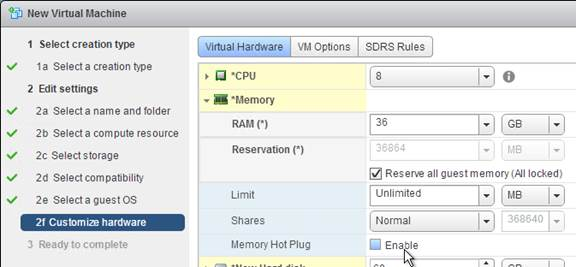
- For vSphere, the NIC must be VMXNET3.
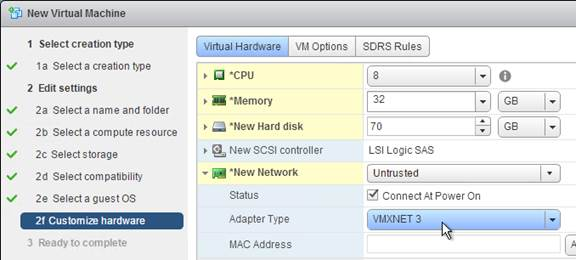
- For vSphere, configure the CD-ROM to boot from IDE instead of SATA. SATA comes with VM hardware version 10. SATA won’t work with PvS.
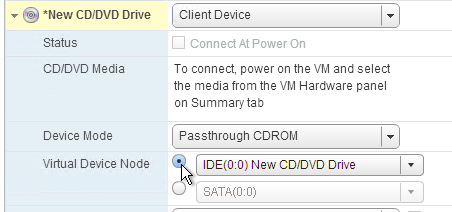
- Do not enable Memory Hot Plug
- Install the latest version of drivers (e.g. VMware Tools).
- If Windows 7 on vSphere, don’t install the VMware SVGA driver. For more details, see CTX201804 Intermittent Connection Failures/Black Screen Issues When Connecting from Multi-Monitor Client Machines to Windows 7 VDA with VDA 7.x on vSphere/ESXi.
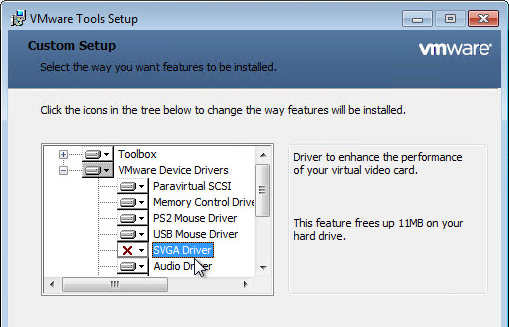
- If Windows 7 on vSphere, don’t install the VMware SVGA driver. For more details, see CTX201804 Intermittent Connection Failures/Black Screen Issues When Connecting from Multi-Monitor Client Machines to Windows 7 VDA with VDA 7.x on vSphere/ESXi.
If vSphere, disable NIC Hotplug
- Users could use the systray icon to Eject the Ethernet Controller. Obviously this is bad.
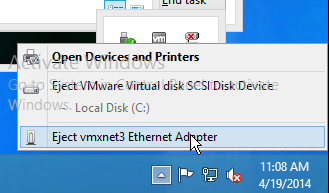
- To disable this functionality, power off the virtual machine.
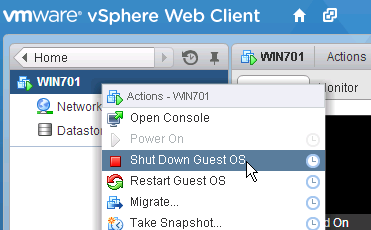
- Once powered off, right-click the virtual machine and click Edit Settings.
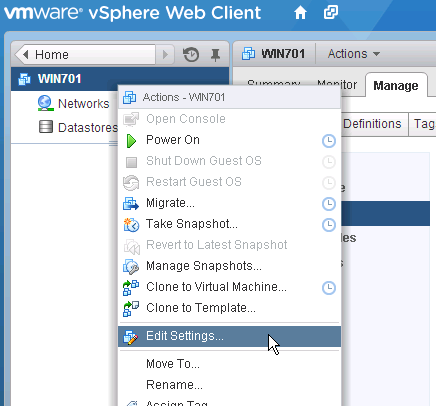
- On the VM Options tab, expand Advanced and then click Edit Configuration.
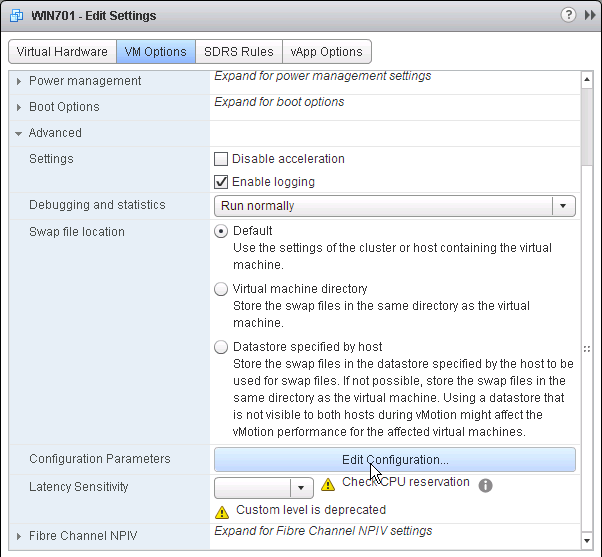
- Click Add Row.
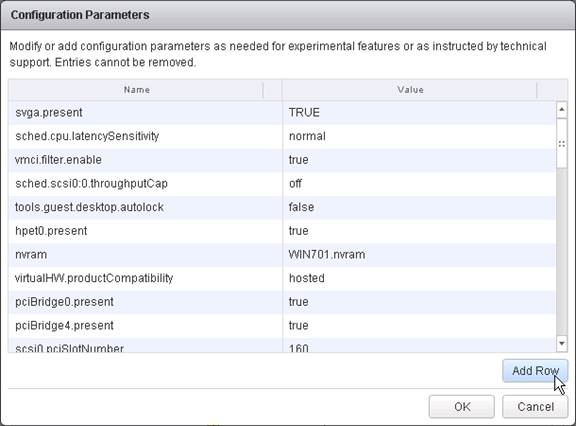
- On the left, enter devices.hotplug. On the right, enter false.
- Then click OK a couple times to close the windows.
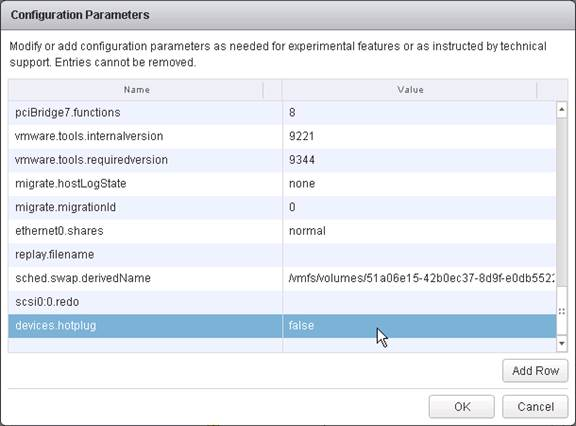
- The VM can then be powered on.
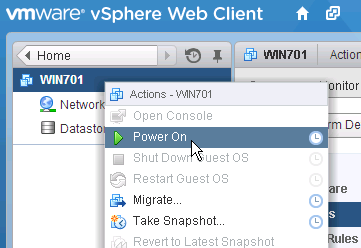
Windows Preparation
- If RDSH, disable IE Enhanced Security Configuration in Server Manager > Local Server.
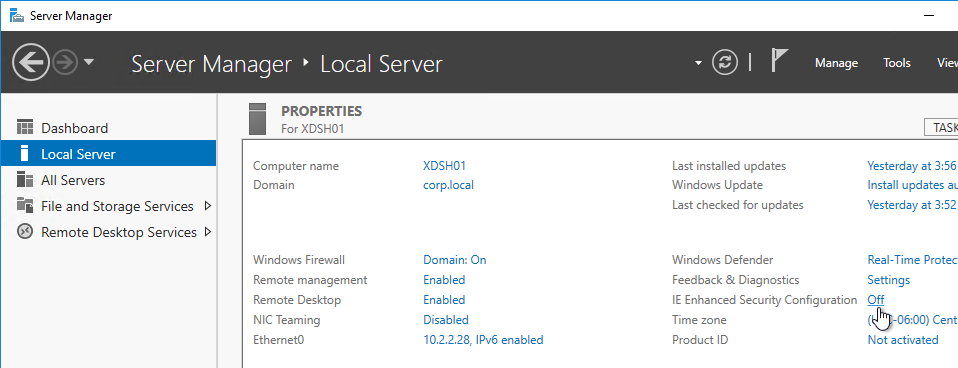
- Optionally, go to Action Center (Windows 8.1 or 2012 R2) or Control Panel > Security and Maintenance (Windows 10/2016) to disable User Account Control and enable SmartScreen .
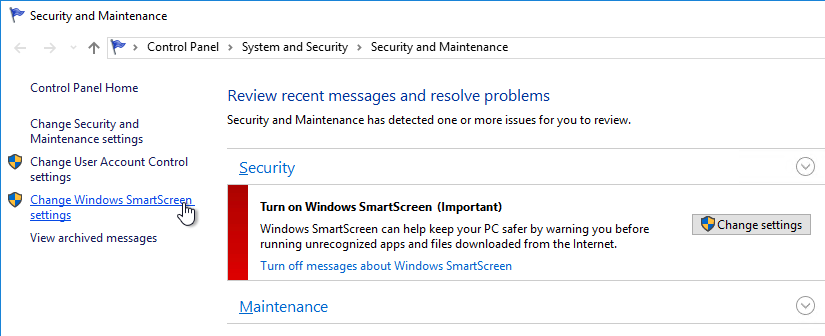
- Run Windows Update.
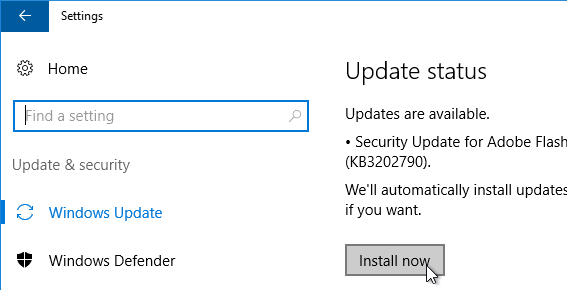
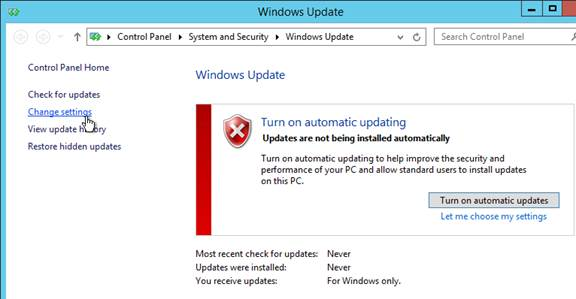
- Add your Citrix Administrators group to the local Administrators group on the VDA. Computer Management.
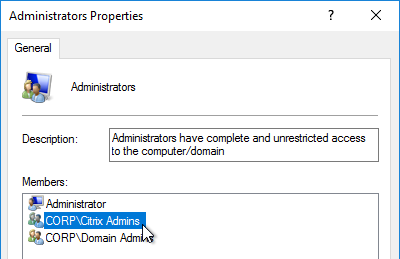
- The Remote Desktop Services “Prompt for Password” policy prevents Single Sign-on to the Virtual Delivery Agent. Check registry key
HKEY_LOCAL_MACHINE\SOFTWARE\Policies\Microsoft\Windows NT\Terminal Services. If fPromptForPassword = 1 then you need to fix group policy. The following GPO setting will prevent Single Sign-on from working.Computer Configuration | Policies | Administrative Templates | Windows Components | Remote Desktop Services | Remote Desktop Session Host | Security | Always prompt for password upon connectionOr set the registry valueHKEY_LOCAL_MACHINE\SOFTWARE\Citrix\PorticaAutoLogon (DWORD) = 0x10. - For Windows 7/2008 R2 VDAs that will use Personal vDisk, or AppDisk, or any other layering technology, install Microsoft hotfix 2614892 A computer stops responding because of a deadlock situation in the Mountmgr.sys driver. This hotfix solved a Personal vDisk Image update issue detailed at Citrix Discussions.
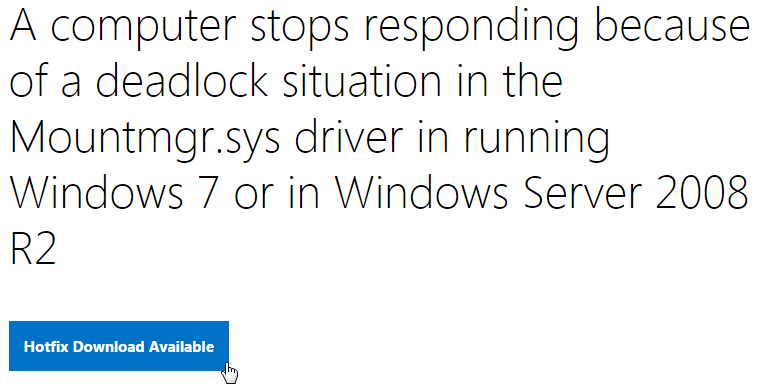
- If this VDA is Windows Server 2008 R2, see https://www.carlstalhood.com/windows-server-2008-r2-post-sp1-hotfixes/.

- To remove the built-in apps in Windows 10, see Robin Hobo How to remove built-in apps in Windows 10 Enterprise.
- For Remote Assistance in Citrix Director, configure the GPO setting Computer Configuration | Policies | Administrative Templates | System | Remote Assistance | Offer Remote Assistance. See Jason Samuel – How to setup Citrix Director Shadowing with Remote Assistance using Group Policy for more details.
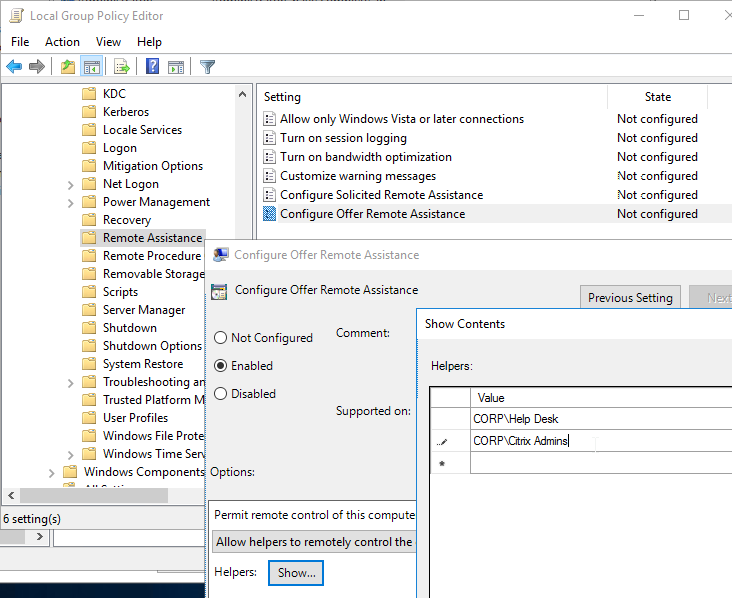
- If you intend to use Citrix’s SCOM Management Packs for XenApp/XenDesktop, make sure WinRM is enabled on the VDA by running winrm quickconfig. Or you can enable WinRM using Group Policy.
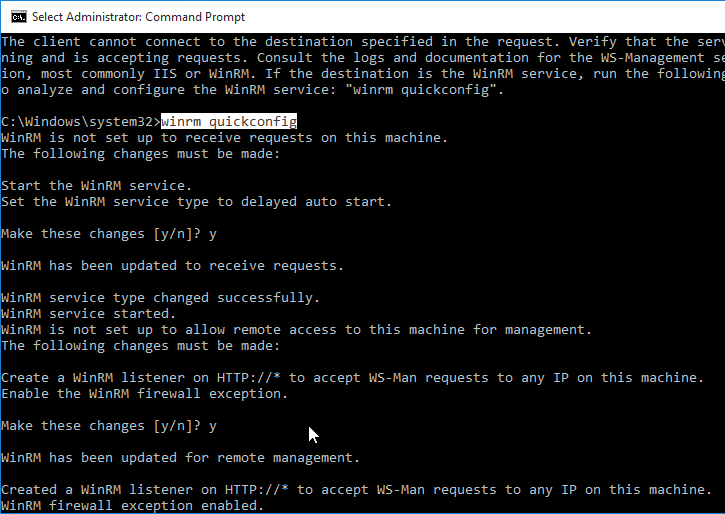
Install Virtual Delivery Agent 7.12
- For virtual desktops, make sure you are logged into the console. The VDA won’t install if you are connected using RDP.
- Make sure .NET Framework 4.5.2 or newer is installed.
CLI Install:
Command Line Install Options are detailed at Install using the command line at Citrix Docs.
The Citrix Telemetry Service seems to cause problems. You can use the Command Line Installer to exclude Telemetry Service as detailed at VDA upgrade cmdlet at Citrix Discussions.
XenDesktopVDASetup.exe /quiet /noreboot /masterimage /Enable_HDX_PORTS /enable_framehawk_port /Enable_REAL_TIME_TRANSPORT /optimize /controllers "xdc01.corp.local xdc02.corp.local" /Exclude "Citrix Telemetry Service"
GUI Install:
- Go to the downloaded XenDesktop 7.12 .iso file and run AutoSelect.exe.
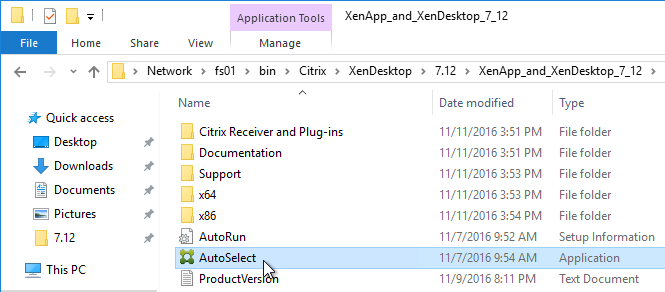
- Alternatively, you can download the standalone VDA package and run that instead. Go the main XenDesktop 7.12 download page. Expand the section labelled Components that are on the product ISO but also packaged separately to download the Standalone VDA installers. 7.12 has a new VDA installer called Desktop OS Core Services that is designed for Remote PC deployments.
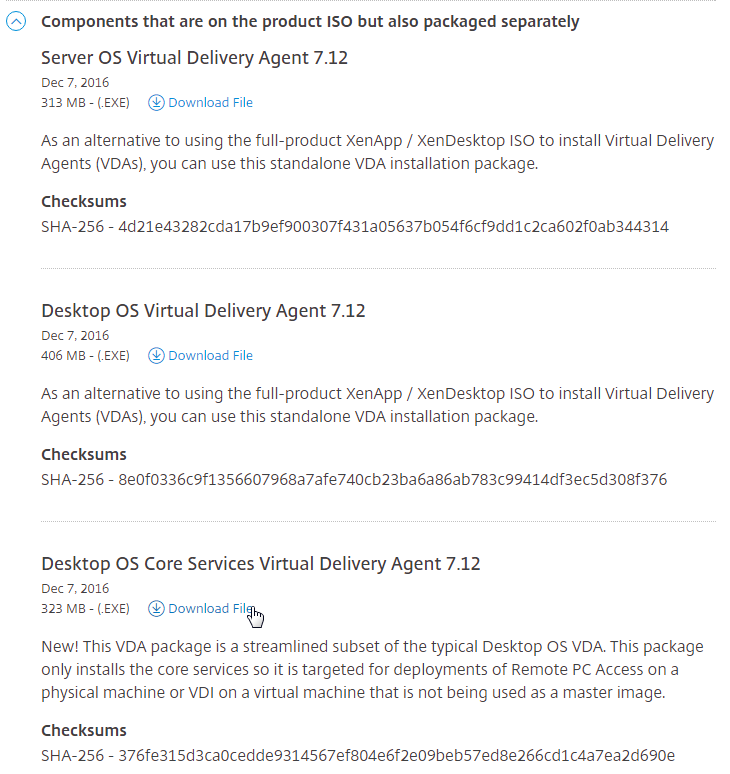
- Click Start next to either XenApp or XenDesktop. The only difference is the product name displayed in the installation wizard.
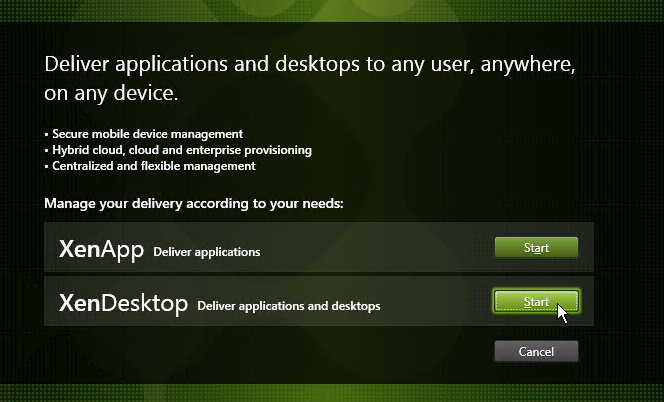
- Click Virtual Delivery Agent for Windows Desktop OS or Windows Server OS depending on which type of VDA you are building.
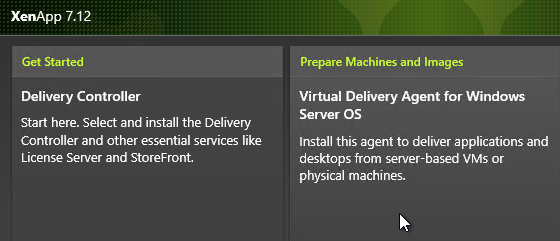
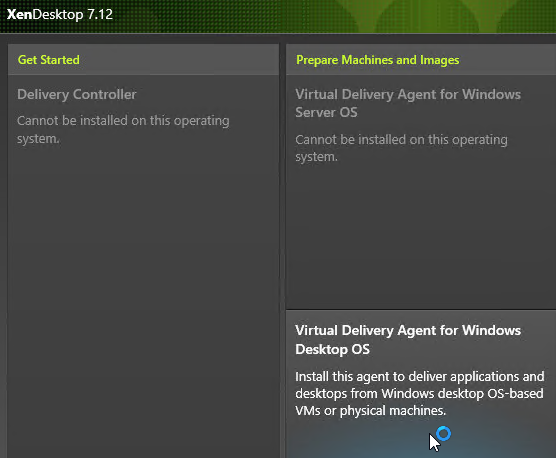
- In the Environment page, select Create a Master Image, and click Next.
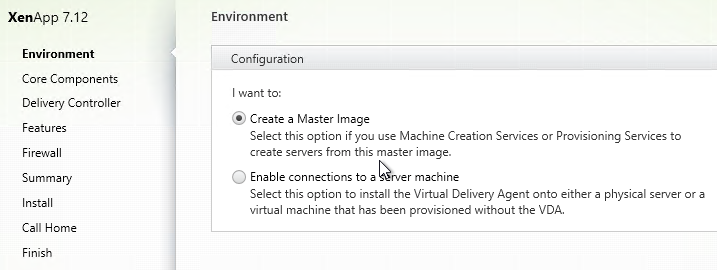
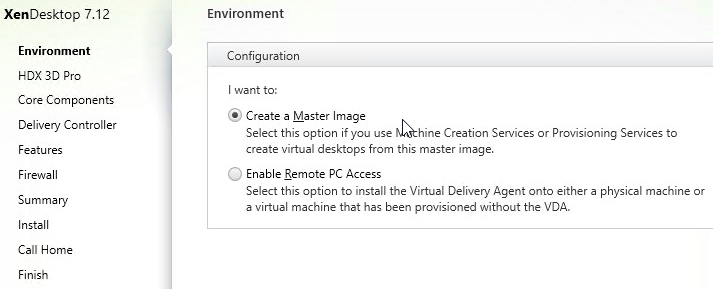
- For virtual desktops, in the HDX 3D Pro page, click Next.
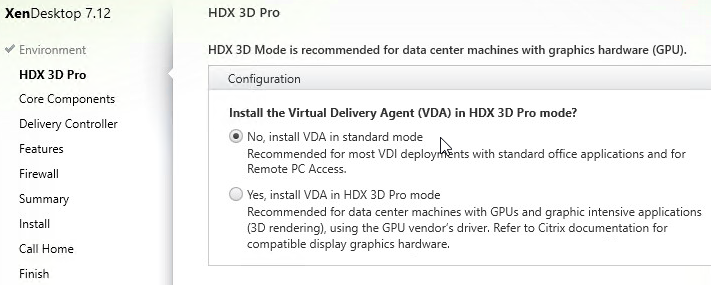
- In the Core Components page, if you don’t need Citrix Receiver installed on your VDA, then uncheck the box. Receiver is usually only needed for double-hop connections (connect to 1st VDA, and then from there, connect to 2nd VDA). Click Next.
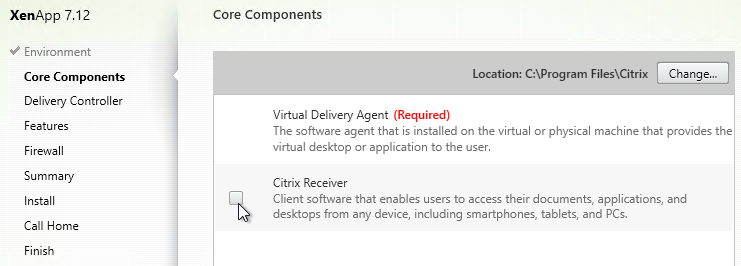
- In the Delivery Controller page, select Do it manually. Enter the FQDN of each Controller. Click Test connection. And then make sure you click Add. Click Next when done.
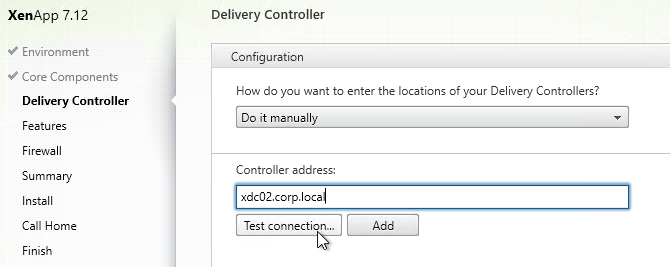
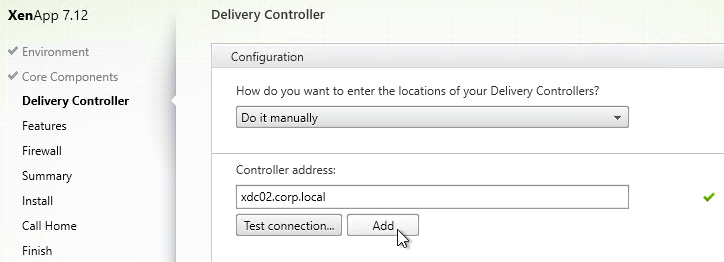
- In the Features page, check boxes. In 7.12 and newer, only the top box is checked by default. If you want to use the other features, check the boxes. If this is a virtual desktop, you can leave Personal vDisk unchecked now and enable it later. Then click Next.
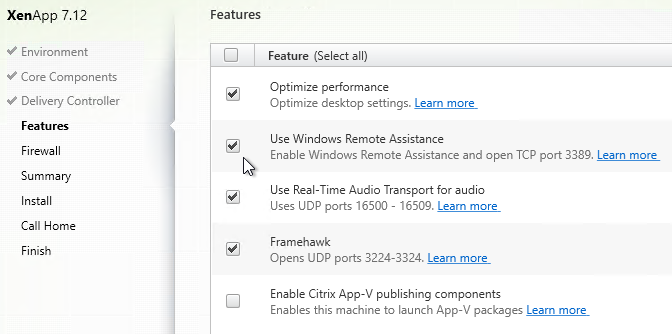
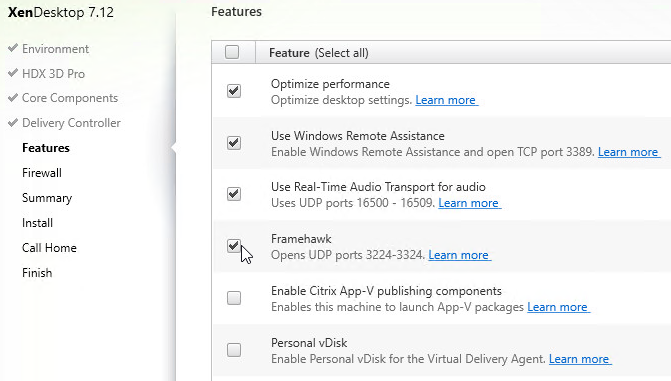
- In the Firewall page, click Next.
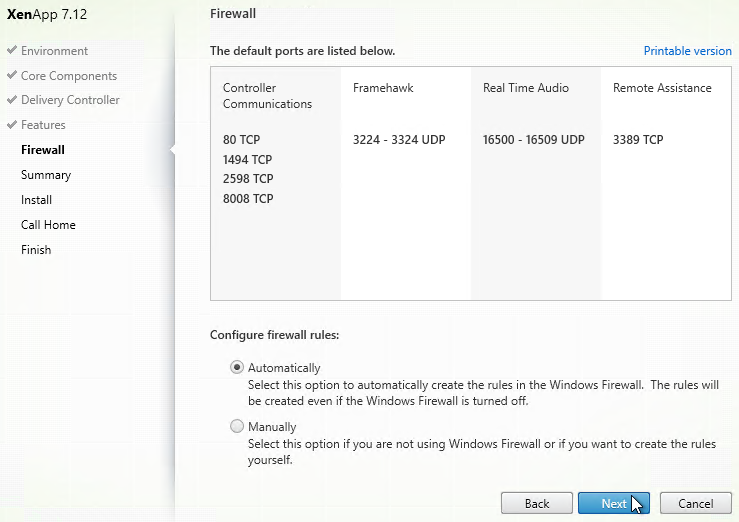
- In the Summary page, click Install.
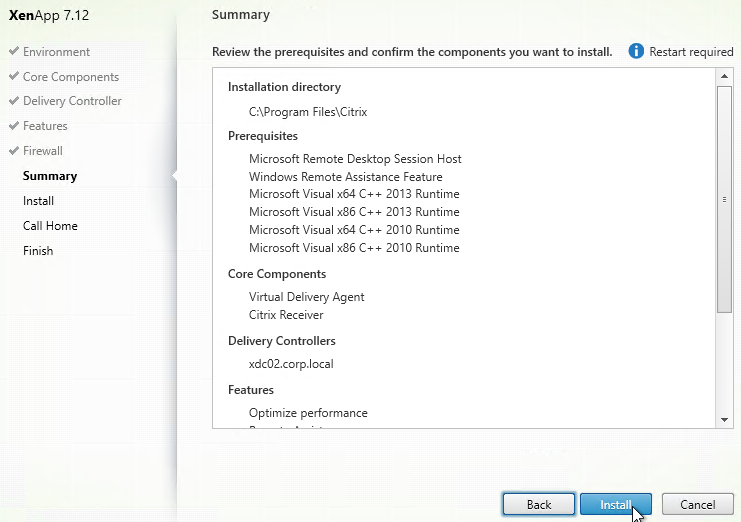
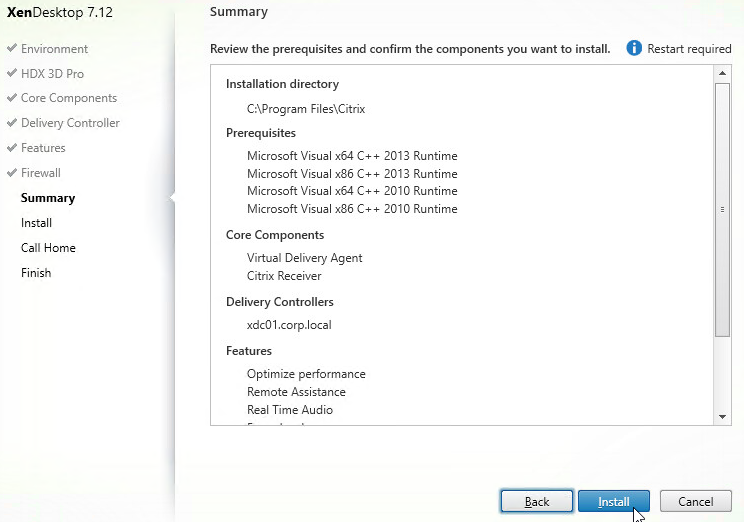
- For RDSH, click Close when you are prompted to restart.

- After the machine reboots twice, login and installation will continue.
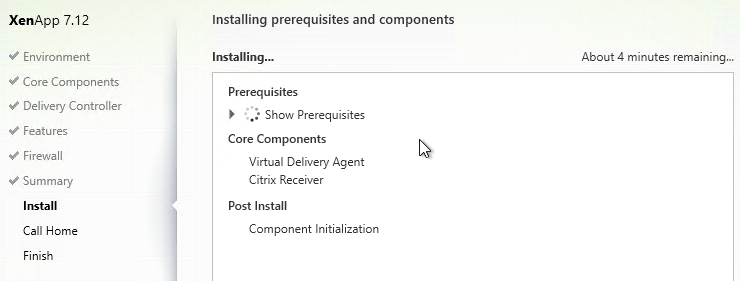
- Note: NT SERVICE\CitrixTelemetryService needs permission to login as a service.
- In the Call Home page, click Connect, enter your MyCitrix credentials, and then click Next.
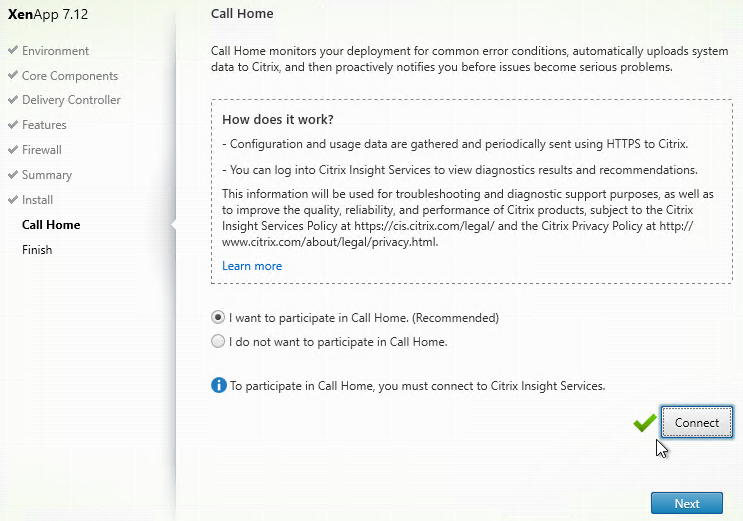
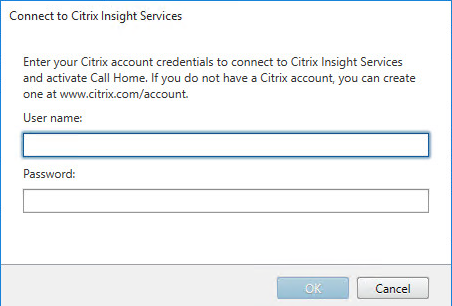
- In the Finish page, click Finish to restart the machine again.
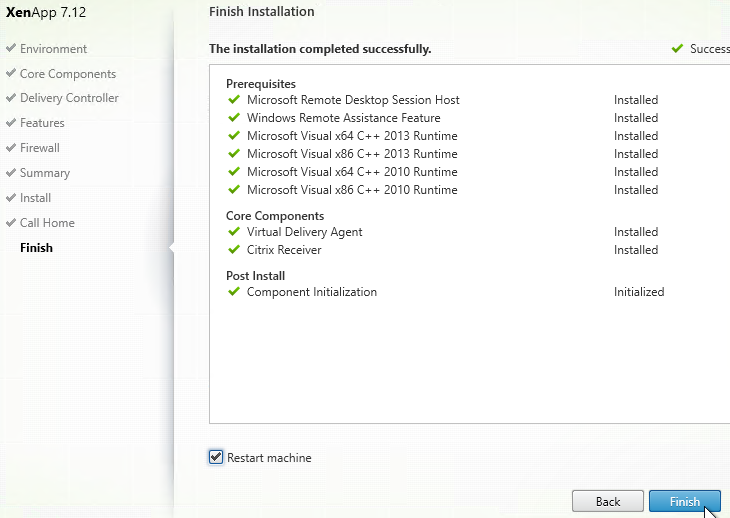
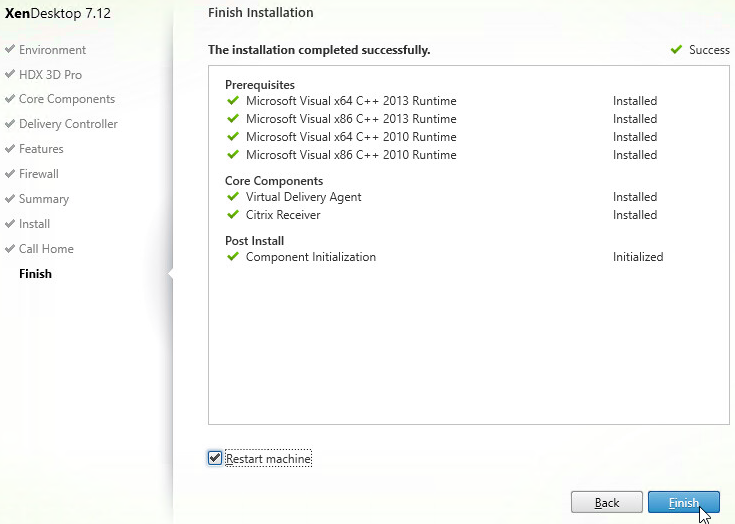
Connection Quality Indicator 💡
The Connection Quality Indicator tells the user the quality of the connection. For example:

Position of the indicator is configurable by the user. Thresholds are configurable through group policy.
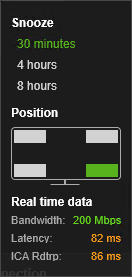
Download it from CTX220774 Connection Quality Indicator and install it. The article is very detailed.
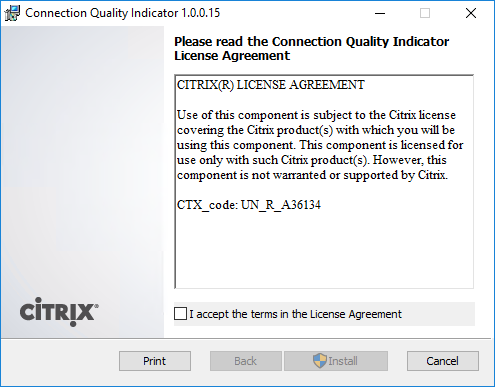
Group Policy templates are located at C:\Program Files (x86)\Citrix\Connection Quality Indicator\Configuration. Copy the files and folder to <Sysvol>\Policies\PolicyDefinitions, or C:\Windows\PolicyDefinitions.
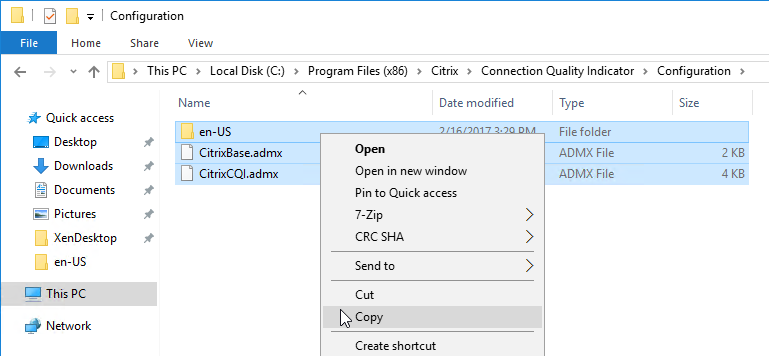
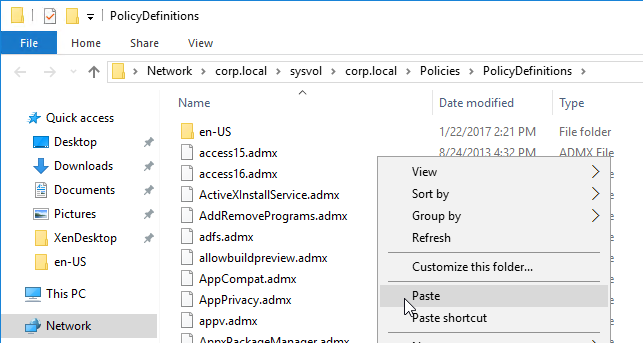
Find the settings under Computer Config | Policies | Admin Templates | Citrix Components | Virtual Desktop Agent | CQI
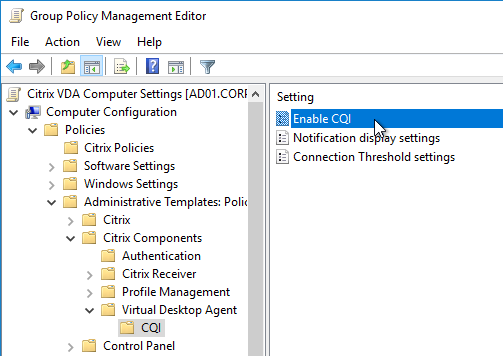
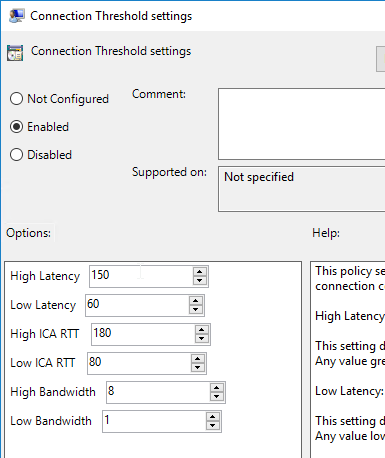
Slow Logons
Citrix Discussions Xenapp 7.9: Wait for local session manager: “I have a Xenapp 7.9 environment on Windows 2012 R2. When logging in through Citrix I got message “Wait for local session manager” for 20-30 seconds. When logging in to the server with RDS, I do not have to wait for this.”
“Add the following 2 registry keys to your 7.9 VDA server – then try connecting to it using ICA to see if the issue still occurs:
Add reg keys in “HKLM\SOFTWARE\Citrix\GroupPolicy”
Dword: “CacheGpoExpireInHours” – Value = 5-24 (# of Hours) ***start with value of 5***
Dword: “GpoCacheEnabled” – Value = 1
Restart the machine after adding these registry keys and attempt an ICA connection (at least twice) to see if that helps the Login delay.”
Mark DePalma at XenApp slow logon times, user get black screen for 20 seconds at Citrix Discussions says that pushing Tile Refresh to a background task speeds up logons.
- Regedit:
Windows Registry Editor Version 5.00 [HKEY_LOCAL_MACHINE\SOFTWARE\Microsoft\Active Setup\Installed Components\DisableUPMResetCache] @="DisableUPMResetCache" "Version"="1,1,1,1" "StubPath"="REG ADD HKCU\\Software\\Microsoft\\Windows\\CurrentVersion\\ImmersiveShell\\StateStore /v ResetCache /t REG_DWORD /d 0 /f" "Locale"="*"
- UPM Exclusions:
Directory - '!ctx_localappdata!\Microsoft\Windows\Caches' Registry - 'SOFTWARE\Microsoft\Active Setup\Installed Components\DisableUPMResetCache'
For additional logon delay troubleshooting, see Alexander Ollischer XenApp/XenDesktop – “Please Wait For Local Session Manager” message when logging into RDS. He found some Windows Updates that caused a logon delay.

XenApp recalculates WMI filters on every reconnect. CTX212610 Session Reconnect 30 sec Delay – DisableGPCalculation – WMI Filters indicates that recalculation can be disabled by setting HKEY_LOCAL_MACHINE\SOFTWARE\Citrix\Reconnect\DisableGPCalculation (DWORD) to 1.
CTX212439 Desktop Session Stuck in Pre-Logon State with Message “Please wait for the Local Session Manager”:
- HKEY_LOCAL_MACHINE\SYSTEM\CurrentControlSet\Control\Lsa\Kerberos\Parameters\MaxTokenSize (DWORD) = 48000
- Delete HKEY_LOCAL_MACHINE\SYSTEM\CurrentControlSet\Control\Terminal Server\RCM\GracePeriod\L$RTMTIMEBOMB
Controller Registration Port
Some environments will not accept the default port 80 for Virtual Delivery Agent registration, even though registration is authenticated and encrypted on port 80. To change the port, do the following on the Virtual Delivery Agent:
- Open Programs and Features.
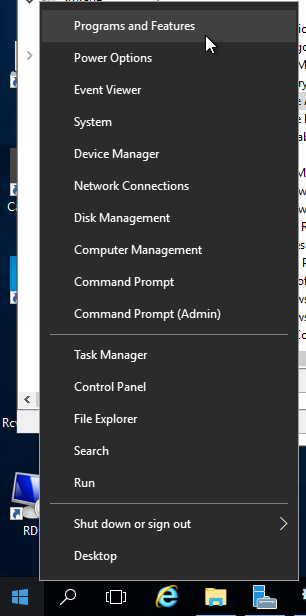
- Find Citrix Virtual Delivery Agent, and click Change.
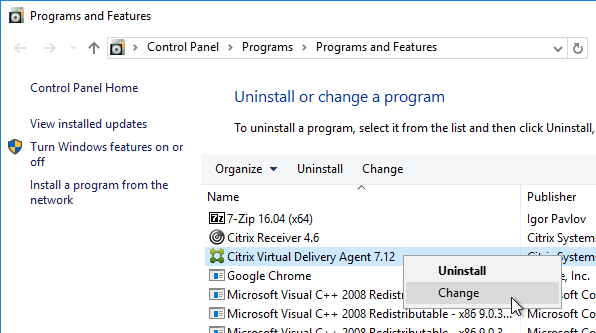
- Click Customize Virtual Delivery Agent Settings.
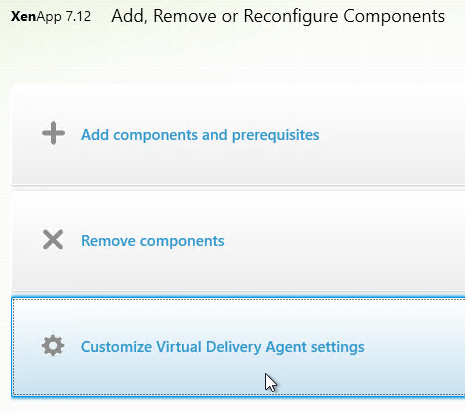
- Edit the Delivery Controllers and click Next.
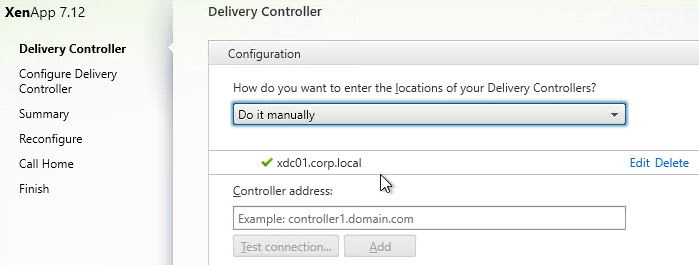
- On the Configure Delivery Controller page, change the port number, and click Next.

- In the Summary page, click Reconfigure.
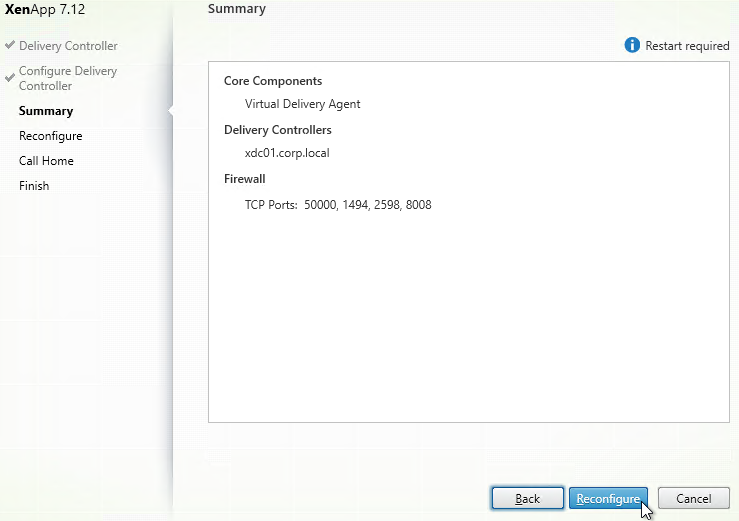
- In the Finish Reconfiguration page, click Finish.
- You must also change the VDA registration port on the Controllers by running
BrokerService.exe /VDAPort.
Controller Registration – Verify
- If you restart the Virtual Delivery Agent machine or restart the Citrix Desktop Service…
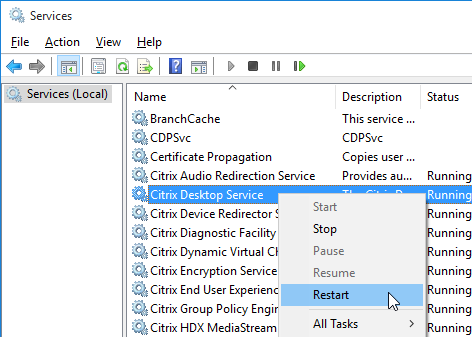
- In Windows Logs Application log, you should see an event 1012 from Citrix Desktop Service saying that it successfully registered with a controller. If you don’t see this then you’ll need to fix the ListOfDDCs registry key.
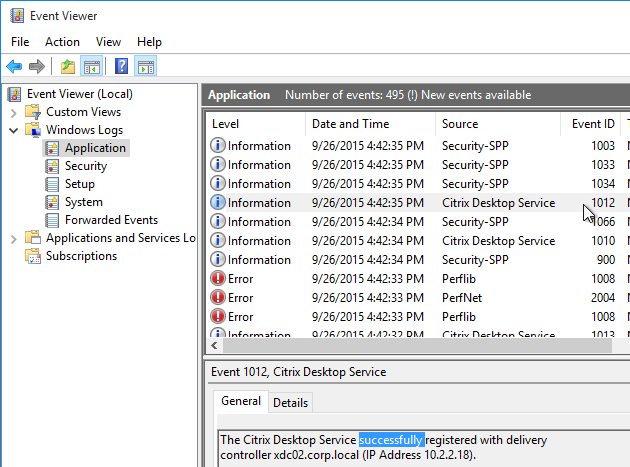
- You can also run Citrix’s Health Assistant on the VDA.
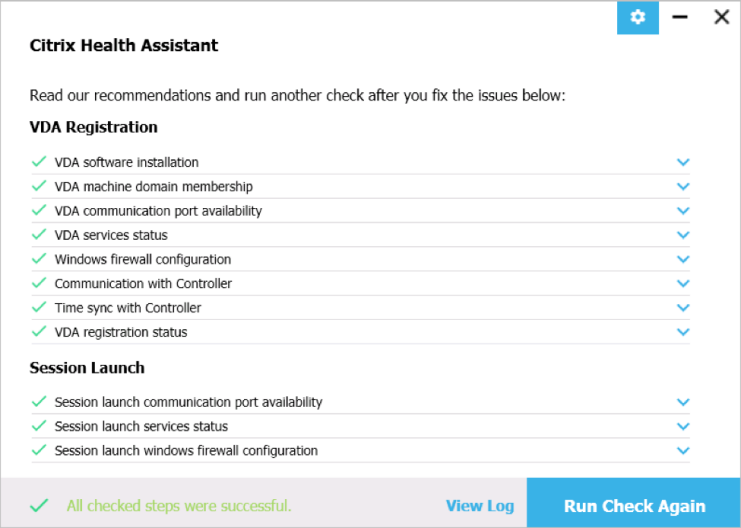
- See CTX220772 Technical Primer: VDA Registration for a very detailed explanation of the VDA Registration process. 💡
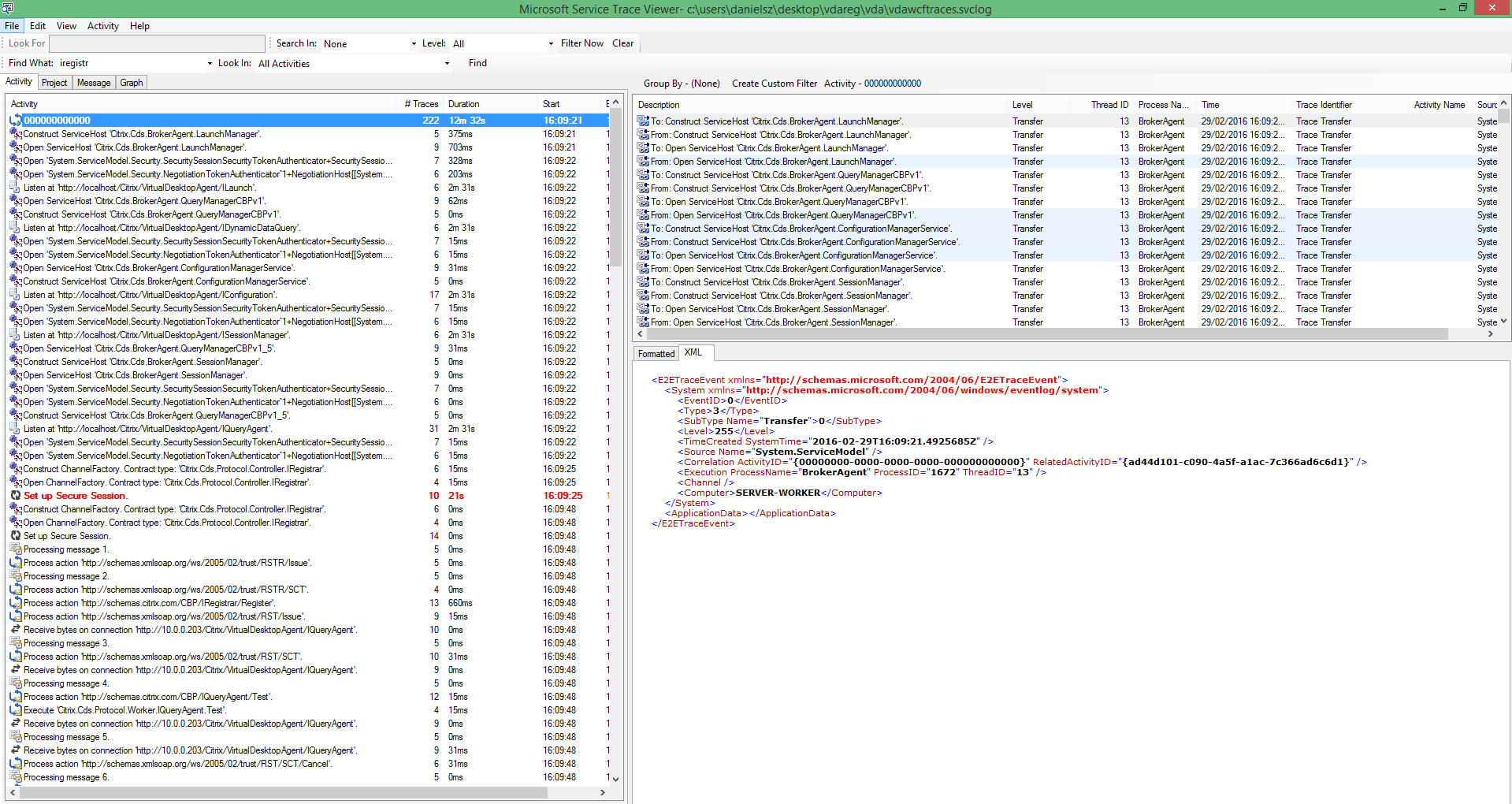
Citrix PDF Printer 7.11.0 for Receiver for HTML5/Chrome
- To allow printing from Receiver for HTML5/Chrome, install Citrix PDF Printer. Get it from the Receiver for HTML5 download page in the Additional Components section. Note: this PDF Printer is only used by Receiver for HTML5 and Receiver for Chrome.
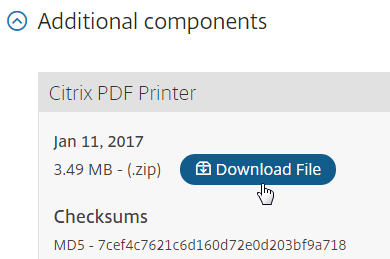
- Go to the extracted CitrixPDFPrinter_7.11.0 and run CitrixPDFPrinter64.msi.

- In the Please read the Citrix PDF printer License Agreement page, check the box next to I accept the terms, and click Install.
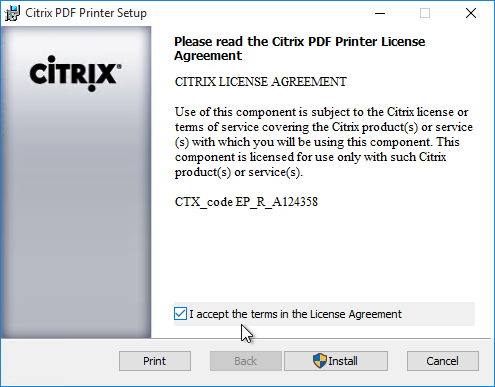
- In the Completed the Citrix PDF Universal Driver Setup Wizard page, click Finish.

- In Programs and Features, it is shown as version 7.8.0.10.
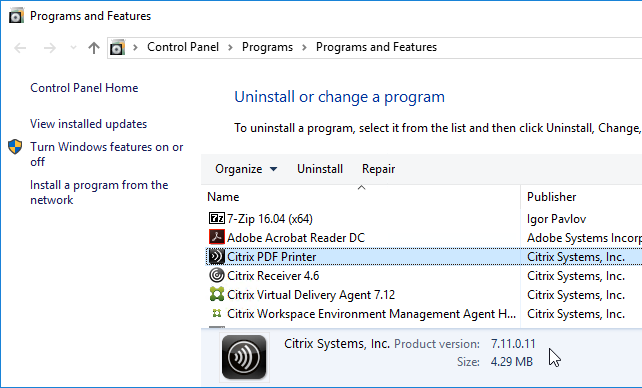
- Configure a Citrix Policy to enable the PDF printer. The setting is called Auto-create PDF Universal Printer in the user half of a Citrix Policy GPO.
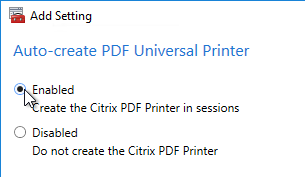
Citrix File Access 2.0.3 for Receiver for Chrome
- If you support Receiver for Chrome (Chromebook) and want to open files on Google Drive using published applications, install Citrix File Access on the VDAs. Get it from the Receiver for Chrome download page, in the Additional Components section.
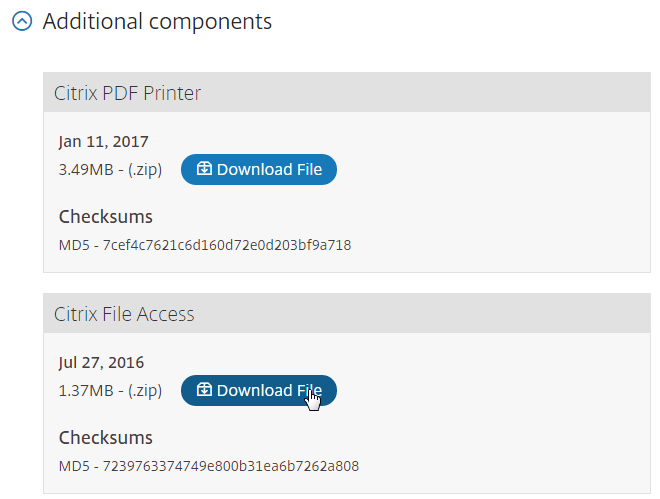
- Go to the extracted Citrix_File_Access_2.0.3 and run FileAccess.msi.

- In the Please read the File Access License Agreement page, check the box next to I accept the terms and click Install.
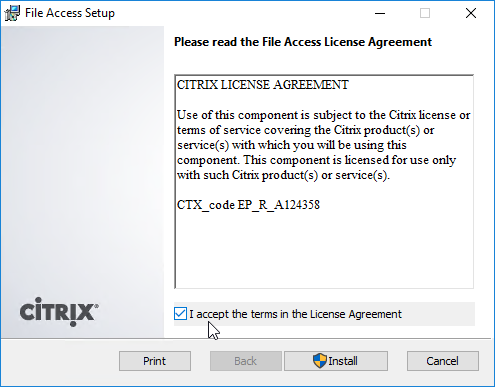
- In the Completed the File Access Setup Wizard page, click Finish.
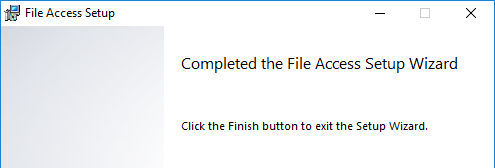
- File Access is listed in Programs and Features as version 2.0.3.33.
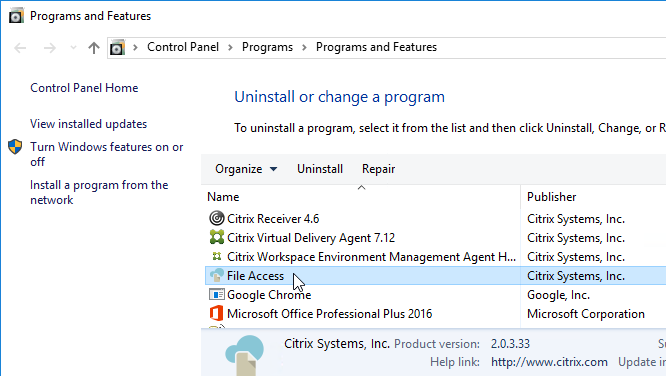
- File Access has a default list of supported file extensions. The list can be expanded by editing the registry on the VDA. See CTX219983 Receiver for Chrome Error: Invalid command line arguments: Unable to open the file as it has an unsupported extension.
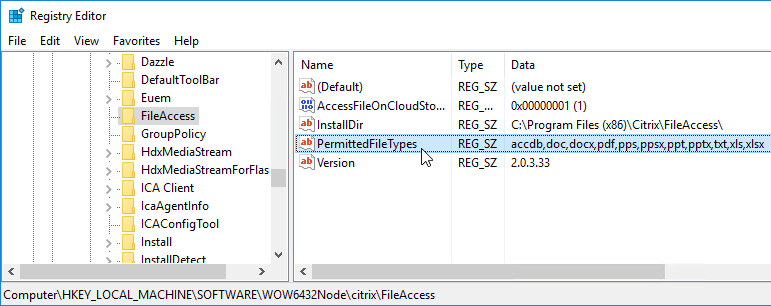
- To open a file from Google Drive, right-click and and open the file using Citrix Receiver.
Framehawk Configuration
To enable Framehawk, see https://www.carlstalhood.com/citrix-policy-settings/#framehawkconfig
Remote Desktop Licensing Configuration
On 2012 R2 and newer RDSH, the only way to configure Remote Desktop Licensing is using group policy (local or domain). This procedure also works for 2008 R2 RDSH. This procedure is not needed on virtual desktops.
- For local group policy, run gpedit.msc. Alternatively, you can configure this in a domain GPO.

- Go to Computer Configuration > Administrative Templates > Windows Components > Remote Desktop Services > Remote Desktop Session Host > Licensing.
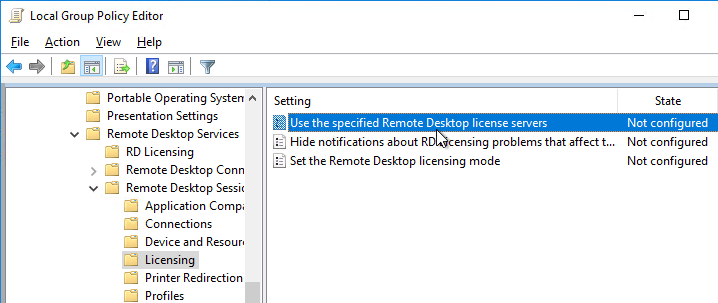
- Double-click Use the specified Remote Desktop license servers. Change it to Enabled, and enter the names of the RDS Licensing Servers (typically installed on XenDesktop Controllers). Click OK.
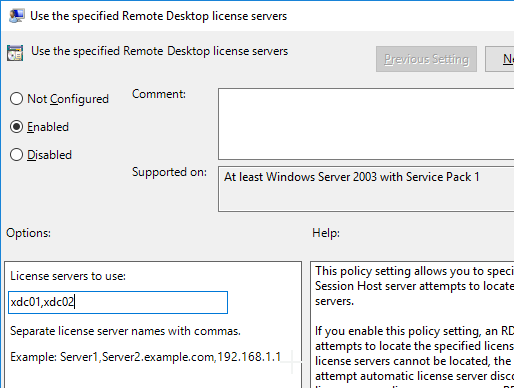
- Double-click Set the Remote Desktop licensing mode. Change it to Enabled and select Per User. Click OK.
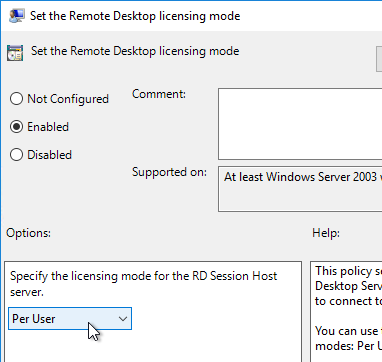
- Optionally, you can install the Remote Desktop Licensing Diagnoser Tool. In the Server Manager > Add Roles and Features Wizard, on the Features page, expand Remote Server Administration Tools, expand Role Administration Tools, expand Remote Desktop Services Tools, and select Remote Desktop Licensing Diagnoser Tool. Then Finish the wizard.
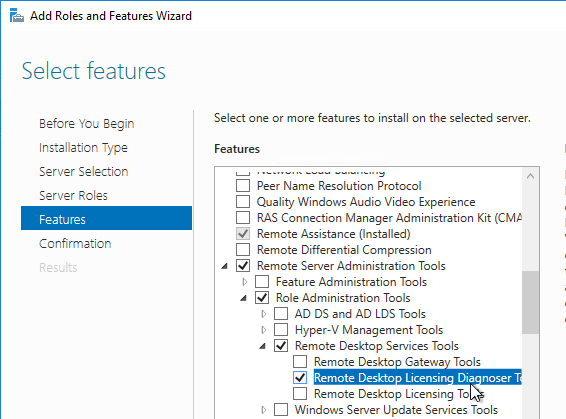
- If it won’t install from Server Manager, you can install it from PowerShell by running
Install-WindowsFeature rsat-rds-licensing-diagnosis-ui.

- In Server Manager, open the Tools menu, expand Remote Desktop Services (or Terminal Services), and click Remote Desktop Licensing Diagnoser.
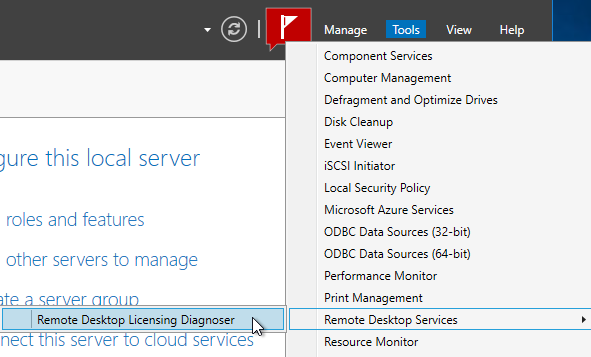
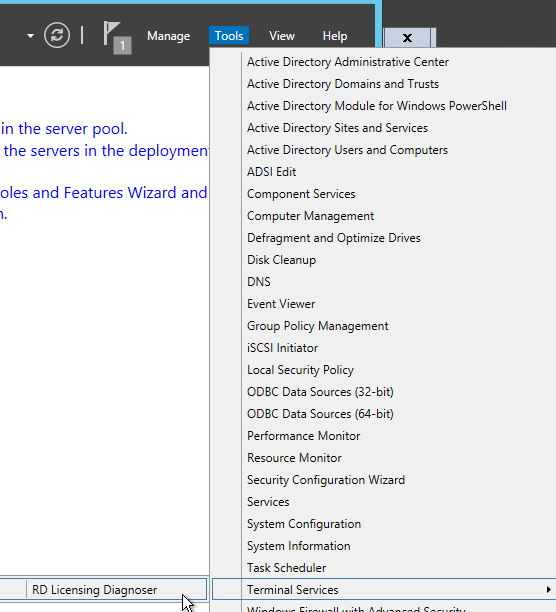
- The Diagnoser should find the license server, and indicate the licensing mode. If you’re configured for Per User licenses, then it’s OK if there are no licenses installed on the Remote Desktop License Server.
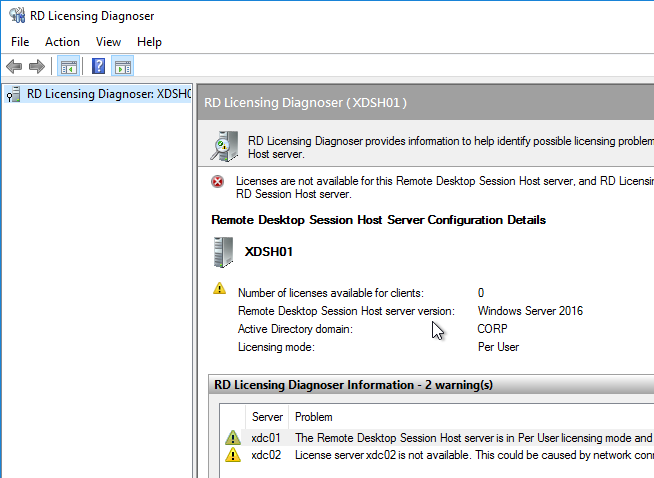
Several people in Citrix Discussions reported the following issue: If you see a message about RD Licensing Grace Period has expired even though RD Licensing is properly configured, see Eric Verdumen No remote Desktop Licence Server availible on RD Session Host server 2012. The solution was to delete the REG_BINARY in HKEY_LOCAL_MACHINE\SYSTEM\CurrentControlSet\Control\Terminal Server\RCM\GracePeriod only leaving the default. You must take ownership and give admin users full control to be able to delete this value.
C: Drive Permissions
This section is more important for shared VDAs like Windows 2008 R2 and Windows 2012 R2.
The default permissions allow users to store files on the C: drive in places other than their profile.
- Open the Properties dialog box for C:.
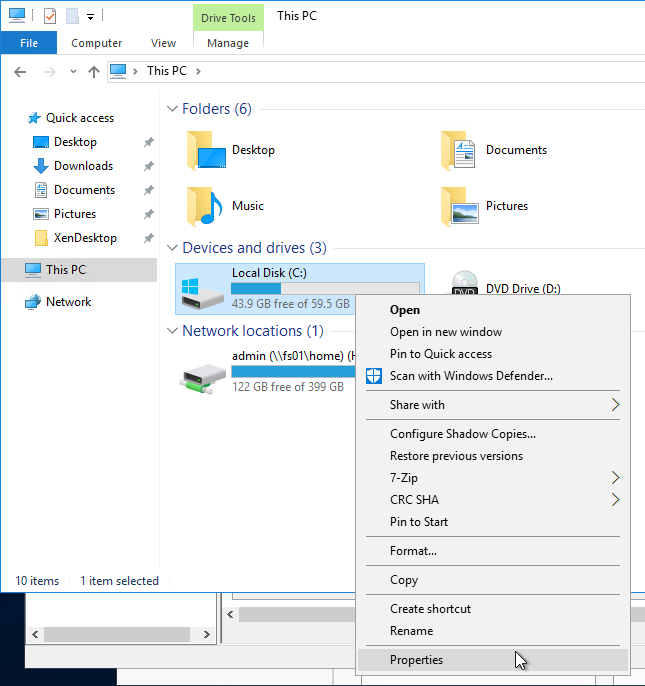
- On the Security tab, click Advanced.
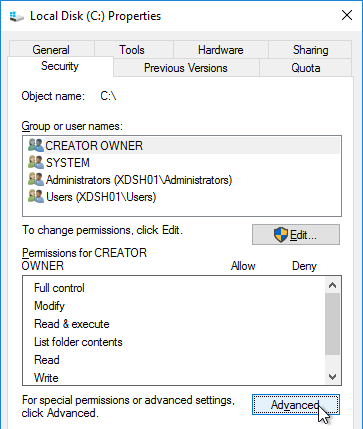
- If UAC is enabled, click Change permissions.
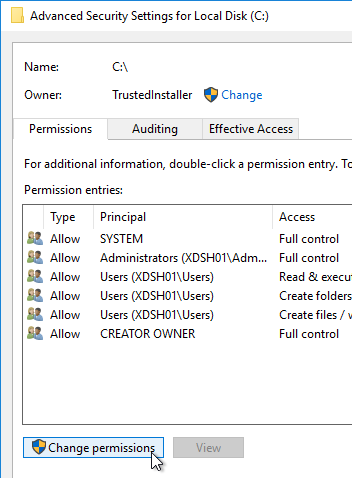
- Highlight the line containing Users and Create Folders, and click Remove.
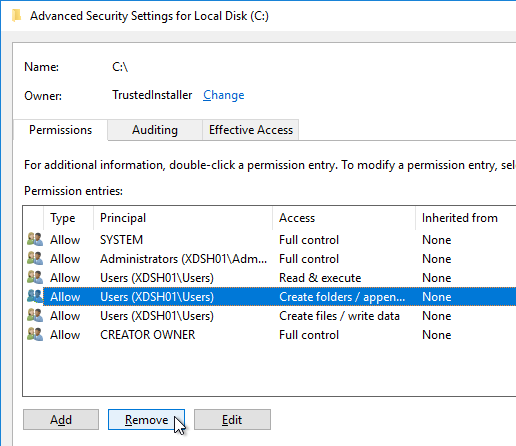
- Highlight the line containing Users and Create files (or Special), and click Remove. Click OK.
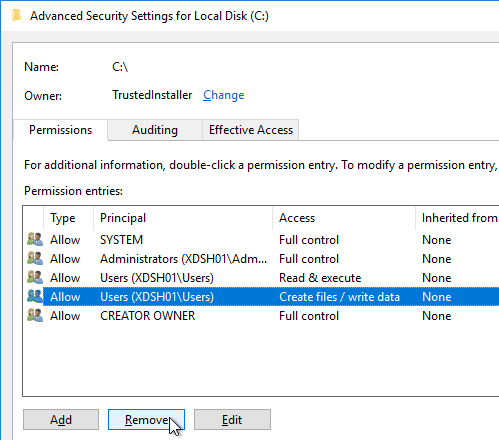
- Click Yes to confirm the permissions change.
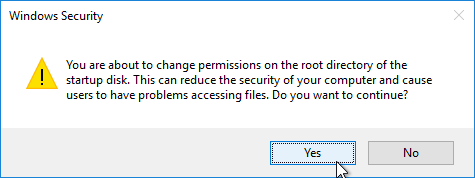
- If you see any of these Error Applying Security windows, click Continue. This window should appear multiple times.
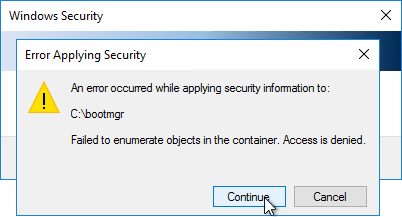
- Click OK to close the C: drive properties.
Pagefile
If this image will be converted to a Provisioning Services vDisk, then you must ensure the pagefile is smaller than the cache disk. For example, if you allocate 20 GB of RAM to your Remote Desktop Session Host, and if the cache disk is only 15 GB, then Windows will have a default pagefile size of 20 GB, and Provisioning Services will be unable to move it to the cache disk. This causes Provisioning Services to cache to server instead of caching to your local cache disk (or RAM).
- Open System. In 2012 R2 and newer, you can right-click the Start button, and click System.
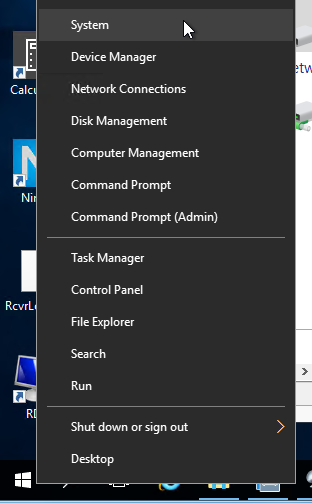
- Click Advanced system settings.
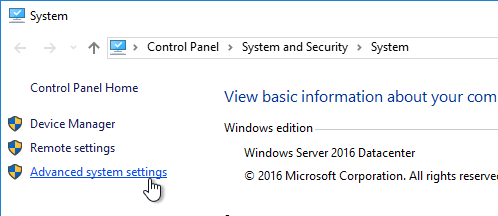
- On the Advanced tab, click the top Settings button.
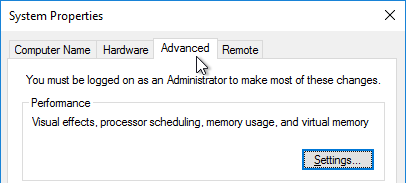
- On the Advanced tab, click Change.
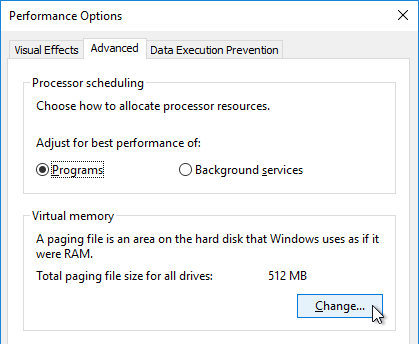
- Uncheck the box next to Automatically manage paging file size for all drives. Then either turn off the pagefile, or set the pagefile to be smaller than the cache disk. Don’t leave it set to System managed size. Click OK several times.
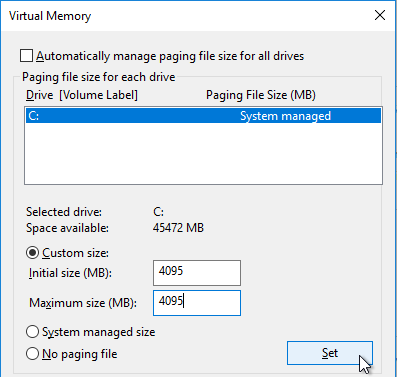
Direct Access Users
When Citrix Virtual Delivery Agent is installed on a machine, non-administrators can no longer RDP to the machine. A new local group called Direct Access Users is created on each Virtual Delivery Agent. Add your non-administrator RDP users to this local group so they can RDP directly to the machine.
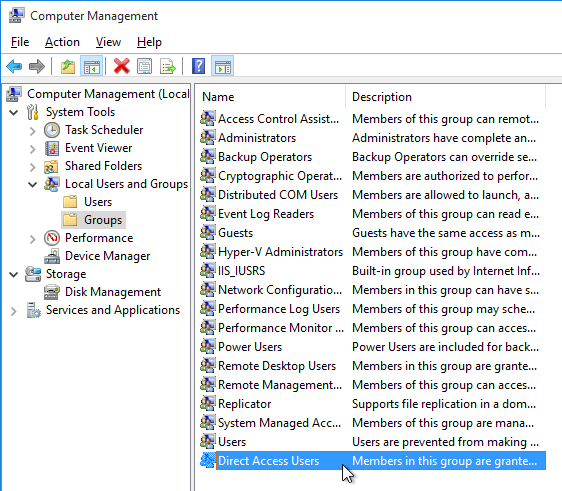
Windows Profiles v3/v4/v5/v6
Roaming Profiles are compatible only between the following client and server operating system pairs. The profile version is also listed.
- v6 = Windows 10 (1607) and Windows Server 2016
- v5 = Windows 10 (1511 and older)
- v4 = Windows 8.1 and Windows Server 2012 R2
- v3 = Windows 8 and Windows Server 2012
- v2 = Windows 7 and Windows Server 2008 R2
- v2 = Windows Vista and Windows Server 2008
For Windows 2012 R2, install Microsoft hotfix 2890783, and set the UseProfilePathExtensionVersion registry value to 1.
Registry
HDX Flash
From Citrix Knowledgebase article CTX139939 – Microsoft Internet Explorer 11 – Citrix Known Issues: The registry key value IEBrowserMaximumMajorVersion is queried by the HDX Flash service to check for maximum Internet Explorer version that HDX Flash supports. For Flash Redirection to work with Internet Explorer 11 set the registry key value IEBrowserMaximumMajorVersion to 11 on the machine where HDX flash service is running. In case of XenDesktop it would be the machine where VDA is installed.
- Key =
HKLM\SOFTWARE\Wow6432Node\Citrix\HdxMediaStreamForFlash\Server\PseudoServer- Value =
IEBrowserMaximumMajorVersion(DWORD) = 00000011 (Decimal)
- Value =
From Citrix Discussions: Add the DWORD ‘FlashPlayerVersionComparisonMask=0′ on the VDA under HKLM\Software\Wow6432Node\Citrix\HdxMediaStreamForFlash\Server\PseudoServer. This disables the Flash major version checking between the VDA and Client Device.
Published Explorer
This section applies if you intend to publish apps from this VDA.
From Citrix Knoweldgebase article CTX128009 Explorer.exe Fails to Launch: When publishing the seamless explorer.exe application, the session initially begins to connect as expected. After the loading, the dialog box disappears and the explorer application fails to appear. On the VDA, use the following registry change to set the length of time a client session waits before disconnecting the session:
- Key = HKLM\
SYSTEM\CurrentControlSet\Control\Citrix\wfshell\TWI- Value =
LogoffCheckerStartupDelayInSeconds(DWORD) = 10 (Hexadecimal)
- Value =
Logon Disclaimer Window Size
From XenApp 7.8 – Session Launch Security/Warning Login Banner at Citrix Discussions: If your logon disclaimer window has scroll bars, set the following registry values:
HKLM\Software\Wow6432node\Citrix\CtxHook\AppInit_DLLS\Multiple Monitor Hook\LogonUIWidth = DWORD:300
HKLM\Software\Wow6432node\Citrix\CtxHook\AppInit_DLLS\Multiple Monitor Hook\LogonUIHeight = DWORD:200
Login Timeout
Citrix CTX203760 VDI Session Launches Then Disappears: XenDesktop, by default, only allows 180 seconds to complete a logon operation. The timeout can be increased by setting the following:
HKLM\SOFTWARE\Citrix\PortICA
Add a new DWORD AutoLogonTimeout and set the value to decimal 240 or higher (up to 3600).
Also see Citrix Discussions Machines in “Registered” State, but VM closes after “Welcome” screen.
Receiver for HTML5/Chrome Enhanced Clipboard
From About Citrix Receiver for Chrome 1.9 at Citrix Docs: To enable enhanced clipboard support, create a REG_SZ registry value HKEY_LOCAL_MACHINE\SYSTEM\CurrentControlSet\Control\Citrix\wfshell\Virtual Clipboard\Additional Formats\HTML Format\Name=”HTML Format”. Create any missing registry keys. This applies to both virtual desktops and Remote Desktop Session Hosts.
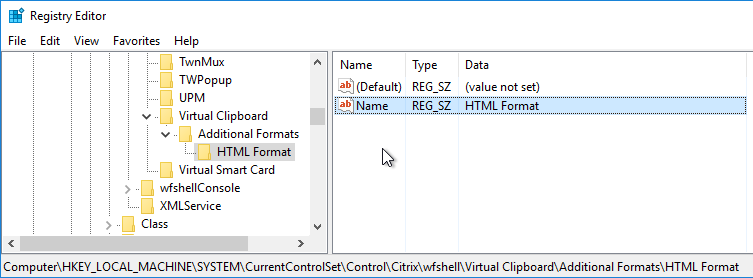
Receiver for HTML5/Chrome Upload Folder
The Receiver for HTML5 (or Chrome) lets upload files.

By default, the user is prompted to select a upload location. If you use the Upload feature multiple times, the last selected folder is not remembered.
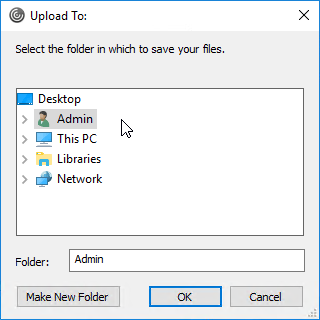
Citrix CTX217351 How to Customize File Upload and Download Using Receiver for HTML5 and Receiver for Chrome. You can specify a default uploads location by editing HKLM\Software\Citrix\FileTransfer\UploadFolderLocation on the VDA. Environment variables are supported. When this value is configured, users are no longer prompted to select an upload location. The change takes effect at next logon.
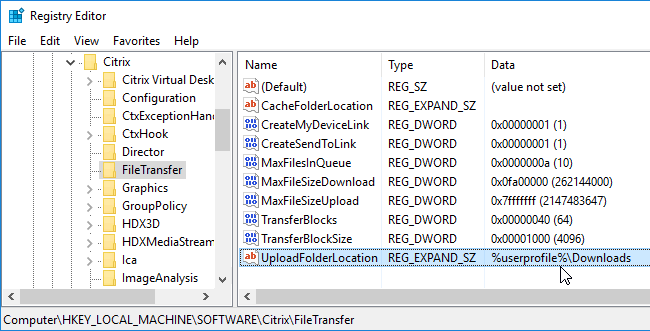
Note: HTML5/Chrome Receiver also adds a Save to My Device location to facilitate downloads.
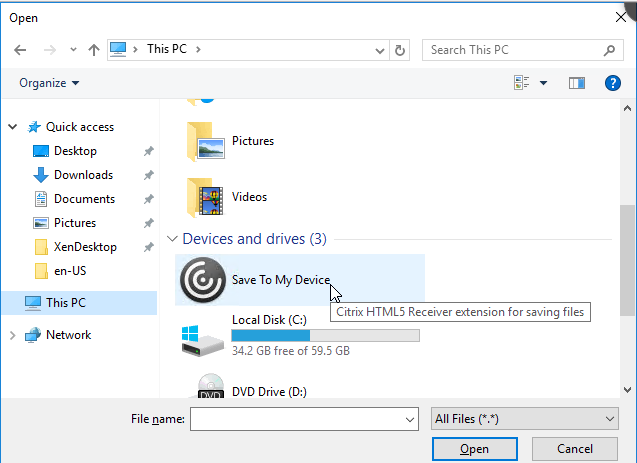
4K Monitors
From Citrix Knowledgebase article CTX218217 Unable to span across multiple monitors after upgrade to 7.11 VDA, Black/Blank screen appears on the monitors while connecting to ICA session: .
- For VDA 7.11 and newer, calculate the video memory that is required for monitors using the following formula:
SumOfAllMons (Width * Height) * 4 / 0.3, where width and height are resolution of the monitor. Note: There is no hard and fast rule that will work for all cases.Example: Consider the resolution of monitor 1 is 1920*1200 and monitor 2 is 1366*768. Then SumOfAllMons will be (1920*1200 + 1366*768)
- CTX115637 Citrix Session Graphics Memory Reference describes how multi-monitor resolution is determined.
- Open the registry (regedit) and navigate to: HKEY_LOCAL_MACHINE\SYSTEM\CurrentControlSet\services\vd3v
- Increase the value of “MaxVideoMemoryBytes” REG_DWORD value to the above calculated memory.
- Reboot the VDA.
Citrix Policies also control graphics performance.
COM Port Threads 💡
CTX212090 COM Port Intermittently Inaccessible During ICA Sessions: increase the default value of “MaxThreads” under the registry key HKEY_LOCAL_MACHINE\SYSTEM\CurrentControlSet\services\picaser\Parameters from 20 to a value greater than the number of COM port connections you want to support. For example, if a XenApp server supports 100 sessions and each session opens two COM ports, the value of “MaxThreads” should be greater than 200.
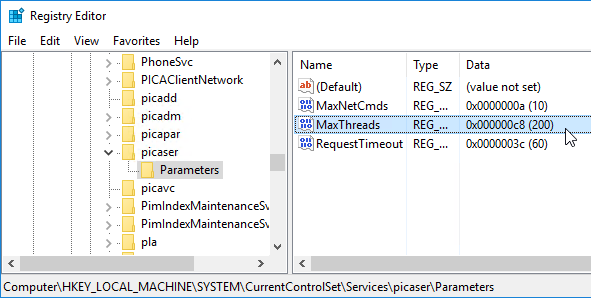
Legacy Client Drive Mapping
Citrix CTX127968 How to Enable Legacy Client Drive Mapping Format on XenApp: Citrix Client Drive Mapping no longer uses drive letters and instead they appear as local disks. This is similar to RDP drive mapping.
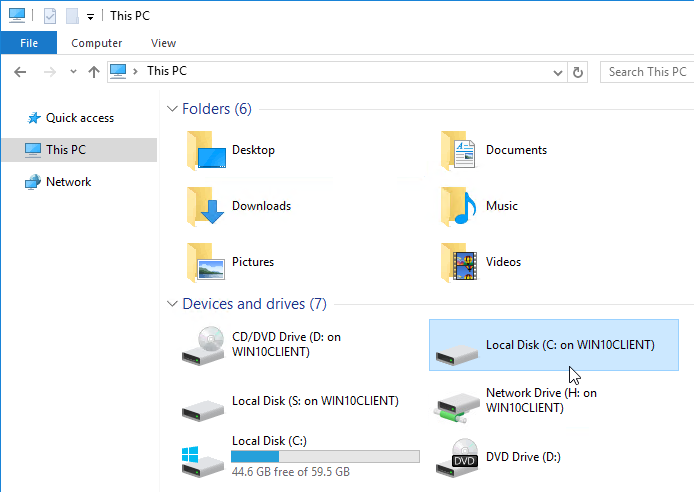
The old drive letter method can be enabled by setting the registry value:
- Key =
HKEY_LOCAL_MACHINE\SOFTWARE\Citrix\UncLinks(create the key)- Value =
UNCEnabled(DWORD) = 0
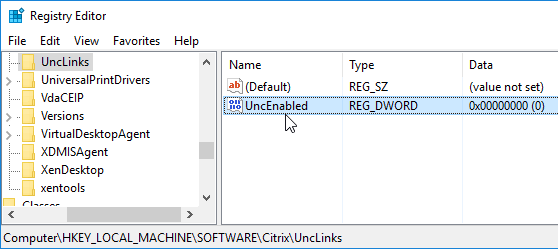
- Value =
When you reconnect, the client drives will be mapped as drive letters (starts with V: and goes backwards).
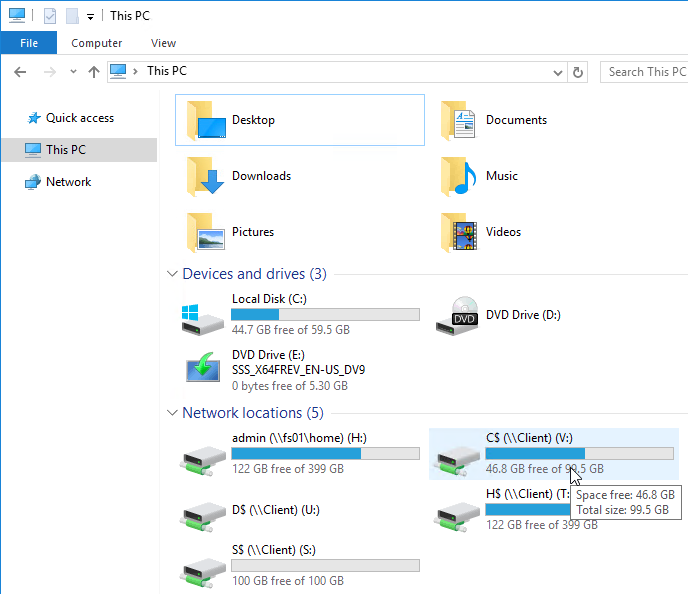
Print Driver for Non-Windows Clients
This section applies to Windows 8.1/2012 and newer VDAs.
From Mac Client Printer Mapping Fix for Windows 8/8.1 and Windows Server 2012/2012R2. By default, Non-Windows clients cannot map printers due to a missing print driver on the VDA machine.
- Requirements:
- Internet Access
- Windows Update service enabled
- Click Start, and run Devices and Printers.
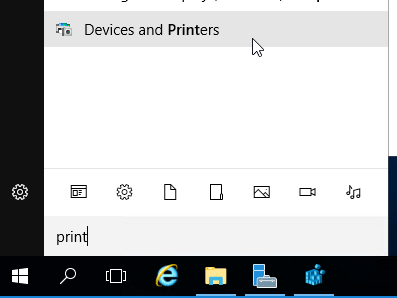
- In the Printers section, highlight a local printer (e.g. Microsoft XPS Document Writer). Then in the toolbar click Print server properties.
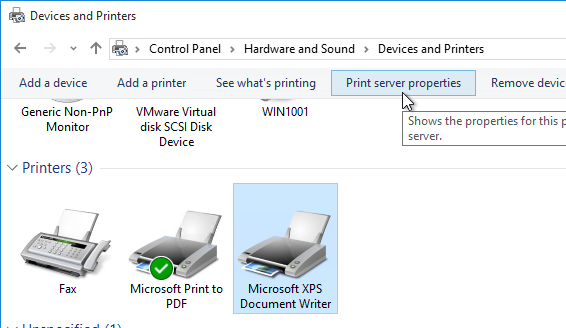
- Switch to the Drivers tab. Click Change Driver Settings.
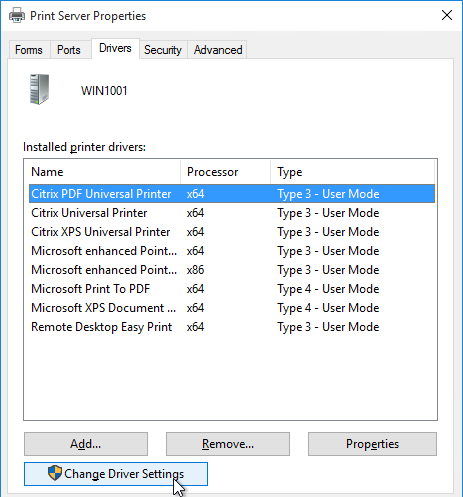
- Then click Add.
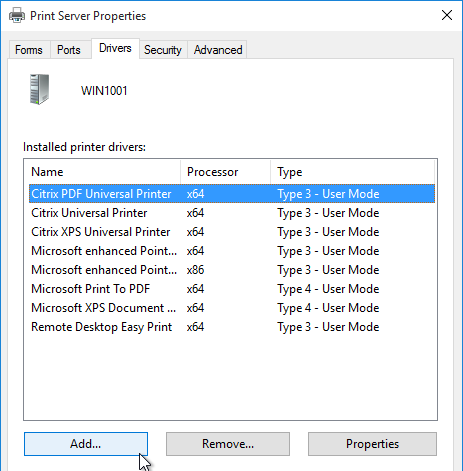
- In the Welcome to the Add Printer Driver Wizard page, click Next.
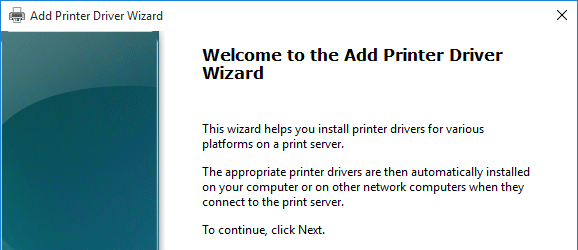
- In the Processor Selection page, click Next.
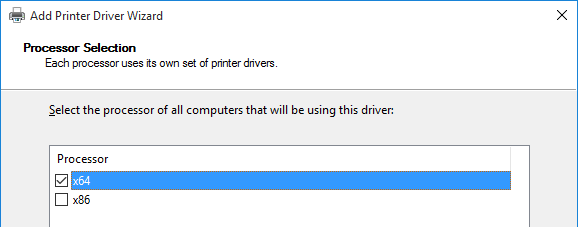
- In the Printer Driver Selection page, click Windows Update. The driver we need won’t be in the list until you click this button. Internet access is required.
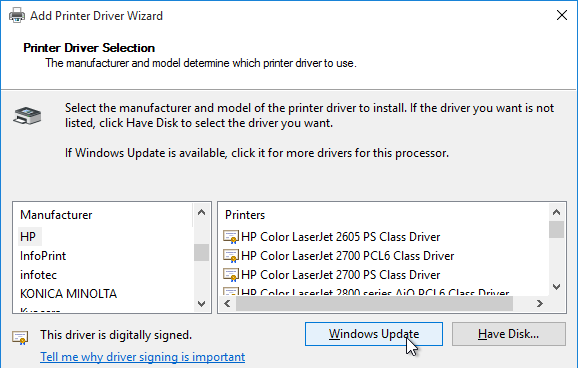
- Once Windows Update is complete, highlight HP on the left and then select HP Color LaserJet 2800 Series PS (Microsoft) on the right. Click Next.
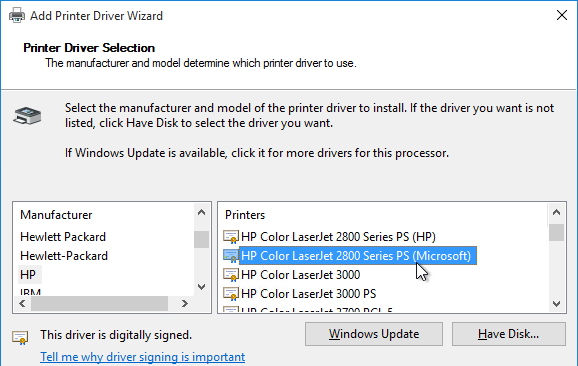
- In the Completing the Add Printer Driver Wizard page, click Finish.
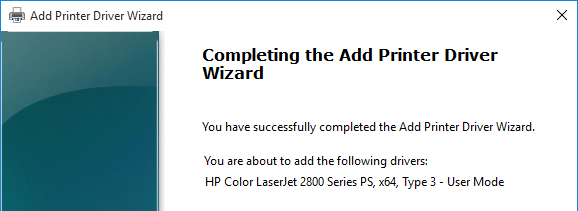
- Repeat these instructions to install the following additional drivers:
- HP LaserJet Series II
- HP Color LaserJet 4500 PCL 5
SSL for VDA
If you intend to use HTML5 Receiver internally, install certificates on the VDAs so the WebSockets (and ICA) connection will be encrypted. Internal HTML5 Receivers will not accept clear text WebSockets. External users don’t have this problem since they are SSL-proxied through NetScaler Gateway. Notes:
- Each Virtual Delivery Agent needs a machine certificate that matches the machine name. This is feasible for a small number of persistent VDAs. For non-persistent VDAs, you’ll need some automatic means for creating machine certificates every time they reboot.
- As detailed in the following procedure, use PowerShell on the Controller to enable SSL for the Delivery Group. This forces SSL for every VDA in the Delivery Group, which means every VDA in the Delivery Group must have SSL certificates installed.
The Citrix blog post How To Secure ICA Connections in XenApp and XenDesktop 7.6 using SSL has a method for automatically provisioning certificates for pooled virtual desktops by enabling certificate auto-enrollment and setting up a task that runs after the certificate has been enrolled. Unfortunately this does not work for Remote Desktop Session Host.
The following instructions can be found at Configure SSL on a VDA using the PowerShell script at Citrix Docs.
- On the VDA machine, run mmc.exe.
- Add the Certificates snap-in.
- Point it to Local Computer.
- Request a certificate from your internal Certificate Authority. You can use either the Computer template or the Web Server template.
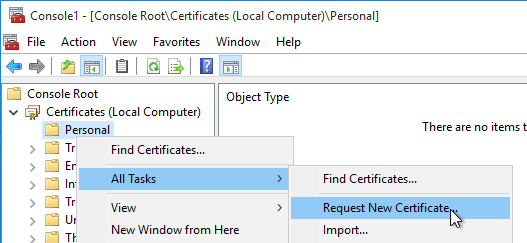 You can also use group policy to enable Certificate Auto-Enrollment for the VDA computers.
You can also use group policy to enable Certificate Auto-Enrollment for the VDA computers.
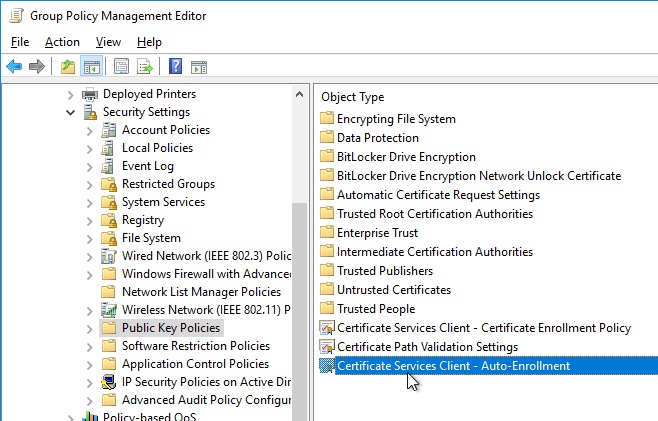
- Browse to the XenApp/XenDesktop 7.12 ISO. In the Support\Tools\SslSupport folder, shift+right-click the Enable-VdaSSL.ps1 script and click Copy as path.
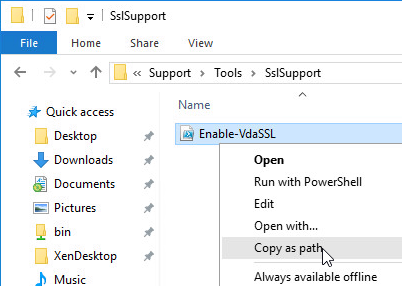
- Run PowerShell as administrator (elevated).
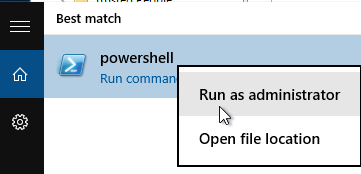
- Run the command Set-ExecutionPolicy unrestricted. Enter Y to approve.

- In the PowerShell prompt, type in an ampersand (&), and a space.
- Right-click the PowerShell prompt to paste in the path copied earlier.
- At the end of the path, type in
-Enable - If there’s only one certificate on this machine, press Enter.

- If there are multiple certificates, you’ll need to specify the thumprint of the certificate you want to use. Open the Certificates snap-in, open the properties of the machine certificate you want to use, and copy the Thumbprint from the Details tab.
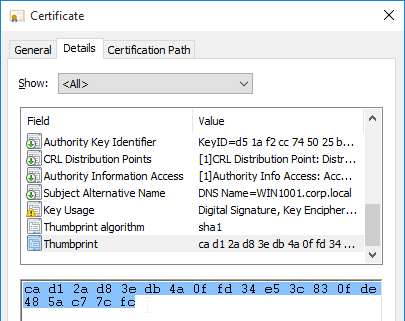 In the PowerShell prompt, at the end of the command, enter
In the PowerShell prompt, at the end of the command, enter?CertificateThumbPrint, add a space, and type quotes (").Right-click the PowerShell prompt to paste the thumbprint.Type quotes (") at the end of the thumbprint. Then remove all spaces from the thumbprint. The thumbprint needs to be wrapped in quotes.

- If this VDA machine has a different service already listening on 443 (e.g. IIS), then the VDA needs to use a different port for SSL connections. At the end of the command in the PowerShell prompt, enter
-SSLPort 444or any other unused port.

- Press <Enter> to run the Enable-VdaSSL.ps1 script.
- Press <Y> twice to configure the ACLs and Firewall.
- You might have to reboot before the settings take effect.
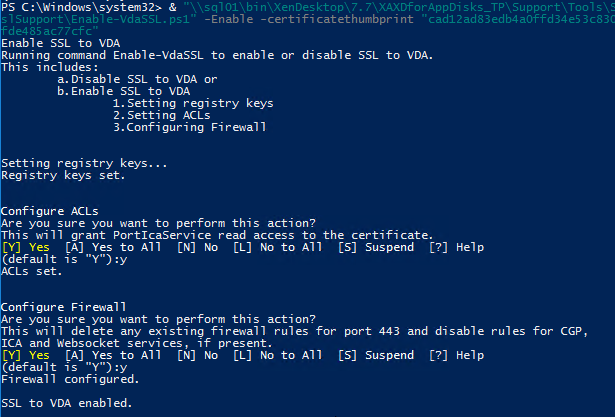
- Login to a Controller, and run PowerShell as Administrator (elevated).
- Run the command
asnp Citrix.*

- Enter the command:
Get-BrokerAccessPolicyRule -DesktopGroupName '<delivery-group-name>' | Set-BrokerAccessPolicyRule ?HdxSslEnabled $true
where <delivery-group-name> is the name of the Delivery Group containing the VDAs.

- You can run
Get-BrokerAccessPolicyRule -DesktopGroupName '<delivery-group-name>'to verify that HDX SSL is enabled.
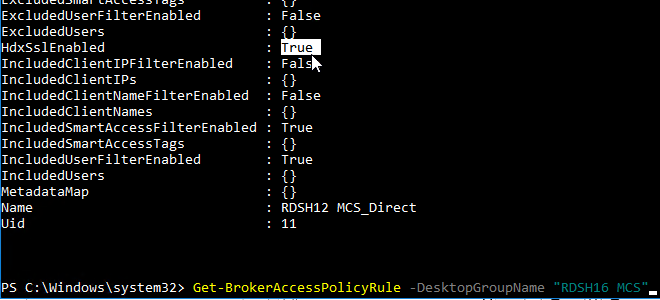
- Also run the following command:
Set-BrokerSite –DnsResolutionEnabled $true

You should now be able to connect to the VDA using the HTML5 Receiver from internal machines.
Anonymous Accounts
If you intend to publish apps anonymously then follow this section.
- Anonymous accounts are created locally on the VDAs. When XenDesktop creates Anon accounts it gives them an idle time as specified at HKEY_LOCAL_MACHINE\SYSTEM\CurrentControlSet\Control\Citrix\AnonymousUserIdleTime. The default is 10 minutes. Adjust as desired.
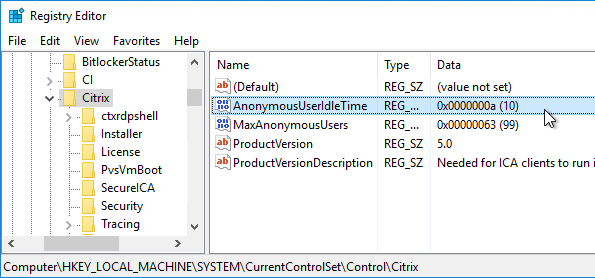
- You can pre-create the Anon accounts on the VDA by running “C:\Program Files\Citrix\ICAConfigTool\CreateAnonymousUsersApp.exe”. If you don’t run this tool then Virtual Delivery Agent will create them automatically when users log in.

- You can see the local Anon accounts by opening Computer Management, expanding System Tools, expand Local Users and Groups and clicking Users.
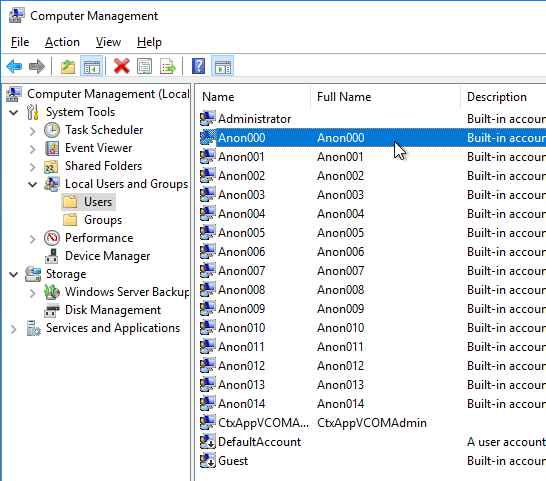
- If you open one of the accounts, on the Sessions tab, notice that idle timeout defaults to 10 minutes. Feel free to change it.
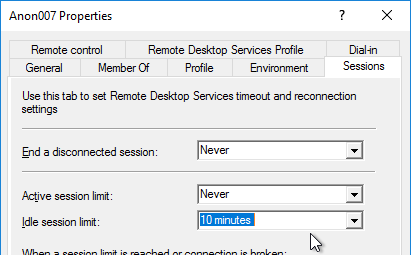
Group Policy for Anonymous Users
Since Anonymous users are local accounts on each Virtual Delivery Agent, domain-based GPOs will not apply. To work around this limitation, you’ll need to edit the local group policy on each Virtual Delivery Agent.
- On the Virtual Delivery Agent, run mmc.exe.
- Open the File menu, and click Add/Remove Snap-in.
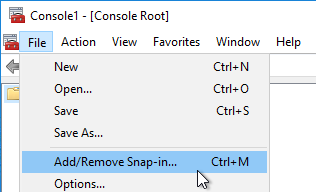
- Highlight Group Policy Object Editor, and click Add to move it to the right.
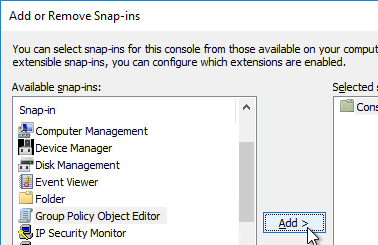
- In the Welcome to the Group Policy Wizard page, click Browse.
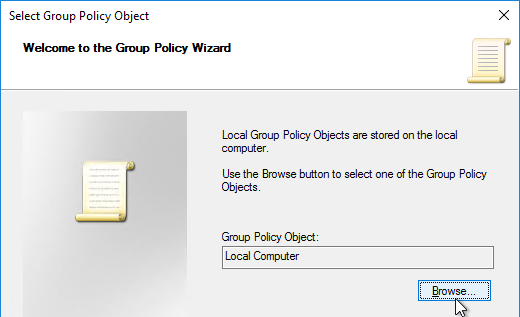

- On the Users tab, select Non-Administrators.
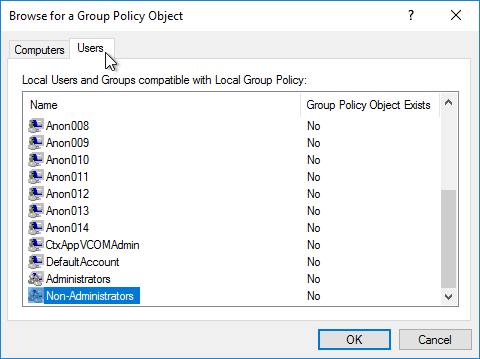
- Click Finish.
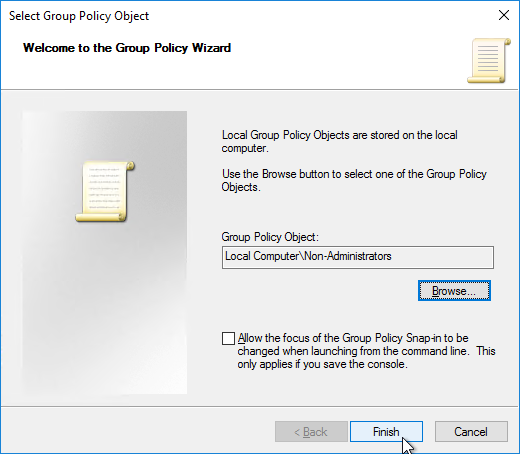
- Now you can configure group policy to lockdown sessions for anonymous users. Since this is a local group policy, you’ll need to repeat the group policy configuration on every Virtual Delivery Agent image. Also, Group Policy Preferences is not available in local group policy.
Antivirus
Install antivirus using your normal procedure. Instructions vary for each Antivirus product.
Microsoft’s virus scanning recommendations (e.g. exclude group policy files) – http://support.microsoft.com/kb/822158.
Citrix’s Recommended Antivirus Exclusions
Citrix Blog Post Citrix Recommended Antivirus Exclusions: the goal here is to provide you with a consolidated list of recommended antivirus exclusions for your Citrix virtualization environment focused on the key processes, folders, and files that we have seen cause issues in the field:
- Set real-time scanning to scan local drives only and not network drives
- Disable scan on boot
- Remove any unnecessary antivirus related entries from the Run key
- Exclude the pagefile(s) from being scanned
- Exclude Windows event logs from being scanned
- Exclude IIS log files from being scanned
See the Blog Post for exclusions for each Citrix component/product including: StoreFront, VDA, Controller, and Provisioning Services. The Blog Post also has links to additional KB articles on antivirus.
Symantec
Symantec links:
- Symantec TECH91070 Citrix and terminal server best practices for Endpoint Protection.
- Symantec TECH197344 Best practices for virtualization with Symantec Endpoint Protection 12.1.2 and later
- Symantec TECH180229 Symantec Endpoint Protection 12.1 – Non-persistent Virtualization Best Practices
- Symantec TECH123419 How to prepare Symantec Endpoint Protection clients on virtual disks for use with Citrix Provisioning Server has a script that automates changing the MAC address registered with Symantec.
- Citrix Blog Post How to prepare a Citrix Provisioning Services Target Device for Symantec Endpoint Protection
Trend Micro
Trend Micro Slow login on Citrix environment after installing OfficeScan (OSCE): The following registries can be used to troubleshoot the issue. These registries will allow a delay on the startup procedure of OSCE until the system has launched successfully. This avoids deadlock situations during login.
Citrix CTX136680 – Slow Server Performance After Trend Micro Installation. Citrix session hosts experience slow response and performance more noticeable while users try to log in to the servers. At some point the performance of the servers is affected, resulting in issues with users logging on and requiring the server to be restarted. This issue is more noticeable on mid to large session host infrastructures.
Trend Micro has provided a registry fix for this type of issue. Create the following registry on all the affected servers. Add new DWORD Value as:
[HKEY_LOCAL_MACHINE\SYSTEM\CurrentControlSet\Services\TmFilterParameters] “DisableCtProcCheck”=dword:00000001
Trend Micro Links:
- Trend Micro Docs – Trend Micro Virtual Desktop Support
- Trend Micro Docs – VDI Pre-Scan Template Generation Tool
- Trend Micro 1055260 – Best practice for setting up Virtual Desktop Infrastructure (VDI) in OfficeScan
- Trend Micro 1056376 – Frequently Asked Questions (FAQs) about Virtual Desktop Infrastructure/Support In OfficeScan
Sophos
Best Practice for running Sophos on virtual systems: we’ve amassed the following practical information about how you can optimize our software to work with this technology.
Sophos Anti-Virus for Windows XP+: Installation and configuration considerations for Sophos Anti-Virus on a Remote Desktop Services server: It maybe desirable to disable the Sophos AutoUpdate shield icon
Sophos Anti-Virus for Windows 2000+: incorporating current versions in a disk image, including for use with cloned virtual machines: This procedure will make sure that the produced target/cloned computers:
- Get their distinct identity with Enterprise Console, under which they can be subsequently managed.
- Have the desired version of Sophos Anti-Virus already installed and configured on the created image.
Optimize Performance
VDA Optimizer
Installation of the VDA might have already done this but there’s no harm in doing it again. This tool is only available if you installed VDA in Master Image mode.
- On the master VDA, go to C:\Program Files\Citrix\PvsVm\TargetOSOptimizer and run TargetOSOptimizer.exe.

- Then click OK. Notice that it disables Windows Update.
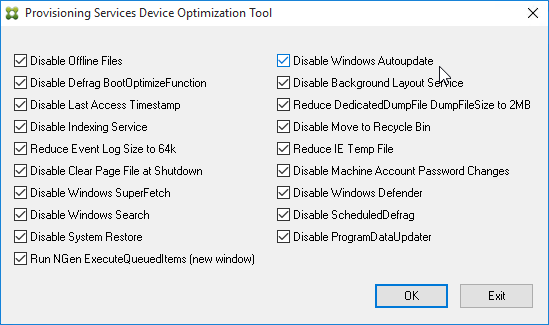
Windows 10 / Windows 2012 R2 / Windows 2016 and newer
- VMware’s OS Optimization Tool plus Login VSI’s tuning template. See VMware Windows Operating System Optimization Tool Guide Technical Paper for details on this tool.
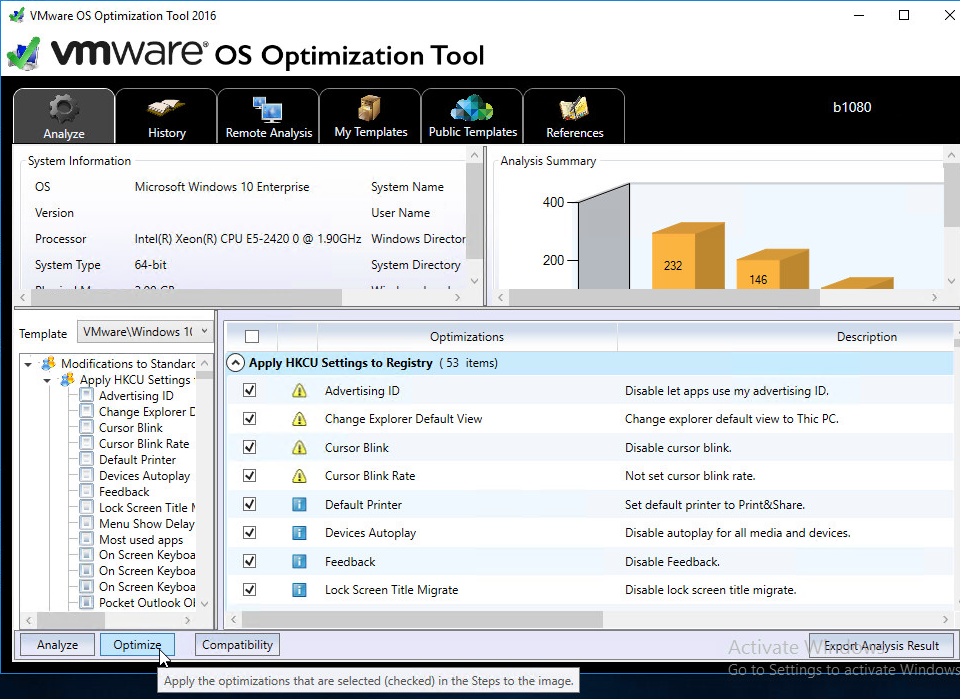
- James Rankin Improving Windows 10 logon time:
- Use Remove-AppXProvisionedPackage to remove Modern apps. See the article for a list of apps to remove. Also see James Rankin Everything you wanted to know about virtualizing, optimizing and managing Windows 10…but were afraid to ask – part #3: MODERN APPS
- Import a Standard Start Tiles layout (Export-StartLayout)
- Create a template user profile
- Citrix’s Windows 10 Optimization Guide – remove built-in apps, delete Scheduled Tasks, disable services, etc.
- Citrix’s Windows 8 and 8.1 Virtual Desktop Optimization Guide contains the following:
- A list of services to disable
- A list of computer settings
- A list of scheduled tasks to disable
- A script to do all of the above
- Carl Luberti (Microsoft) Windows 10 VDI Optimization Script
- Microsoft’s Windows 8 VDI optimization script.
- Desktop Virtualization Best Practice Analyzer (BP Analyzer)
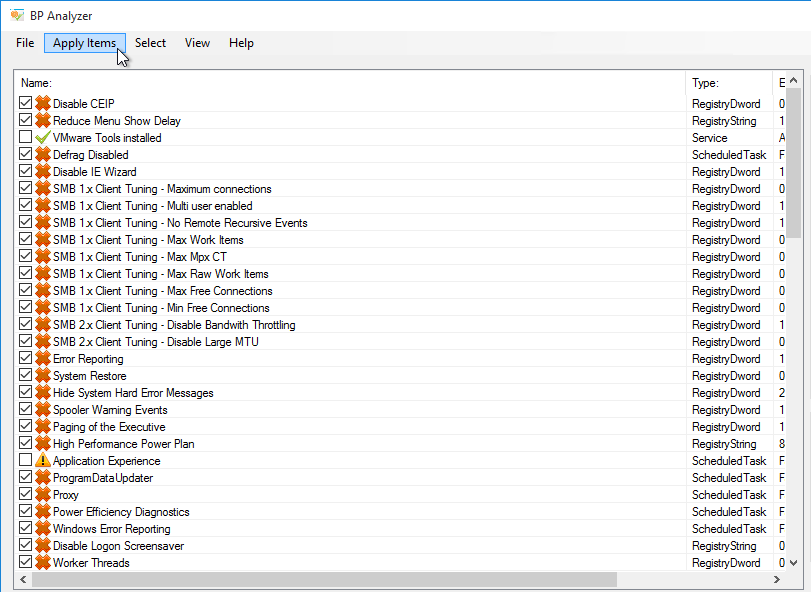
Optimization Notes:
- If this machine is provisioned using Provisioning Services, do not disable the Shadow Copy services.
- Windows 8 detects VDI and automatically disables SuperFetch. No need to disable it yourself.
- Windows 8 automatically disables RSS and TaskOffload if not supported by the NIC.
RDSH 2008 R2
Citrix CTX131577 XenApp 6.x (Windows 2008 R2) – Optimization Guide is a document with several registry modifications that are supposed to improve server performance. Ignore the XenApp 6 content and instead focus on the Windows content.
Citrix CTX131995 User Cannot Launch Application in Seamless Mode in a Provisioning Services Server when XenApp Optimization Best Practices are Applied. Do not enable NtfsDisable8dot3NameCreation.
Citrix CTX213540 Unable To View Printers In Devices And Printers Win 2012 R2 – don’t disable Device Setup Manager Service
Norskale has Windows 2008 R2 Remote Desktop and XenApp 6 Tuning Tips Update.
Windows 7
Microsoft has compiled a list of links to various optimization guides.
It’s a common practice to optimize a Windows 7 virtual machine (VM) template (or image) specifically for VDI use. Usually such customizations include the following.
- Minimize the footprint, e.g. disable some features and services that are not required when the OS is used in “stateless” or “non-persistent” fashion. This is especially true for disk-intensive workloads since disk I/O is a common bottleneck for VDI deployment. (Especially if there are multiple VMs with the same I/O patterns that are timely aligned).
- Lock down user interface (e.g. optimize for specific task workers).
With that said the certain practices are quite debatable and vary between actual real-world deployments. Exact choices whether to disable this or that particular component depend on customer requirements and VDI usage patterns. E.g. in personalized virtual desktop scenario there’s much less things to disable since the machine is not completely “stateless”. Some customers rely heavily on particular UI functions and other can relatively easily trade them off for the sake of performance or standardization (thus enhance supportability and potentially security). This is one of the primary reasons why Microsoft doesn’t publish any “VDI Tuning” guide officially.
Though there are a number of such papers and even tools published either by the community or third parties. This Wiki page is aimed to serve as a consolidated and comprehensive list of such resources.
Daniel Ruiz XenDesktop Windows 7 Optimization and GPO’s Settings –
Microsoft Whitepaper Performance Optimization Guidelines for Windows 7 Desktop Virtualization
Seal and Shut Down
If this session host will be a master image in a Machine Creation Services or Provisioning Services catalog, after the master is fully prepared (including applications), do the following:
- Go to the properties of the C: drive and run Disk Cleanup.
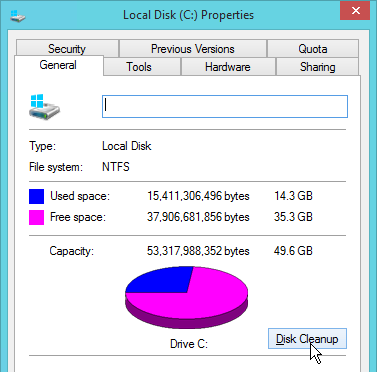
- If Disk Cleanup is missing, you can run cleanmgr.exe instead.

- On the Tools tab, click Optimize to defrag the drive.
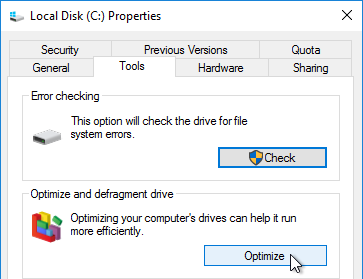 `
` - Run slmgr.vbs /dlv and make sure it is licensed with KMS and has at least one rearm remaining. It is no longer necessary to manually rearm licensing. XenDesktop will do it automatically.
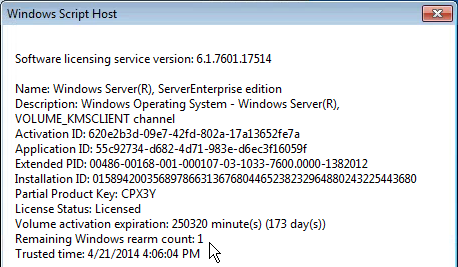
- Run Delprof2 to clean up local profiles. Get it from http://helgeklein.com/download/.

- Machine Creation Services and Provisioning Services require DHCP.
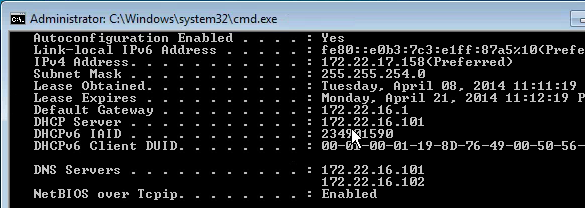
Session hosts commonly have DHCP reservations.
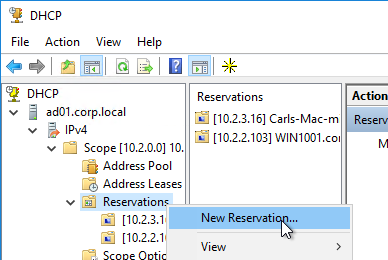
Shut down the master image. You can now use Studio or Provisioning Services to create a catalog of linked clones.
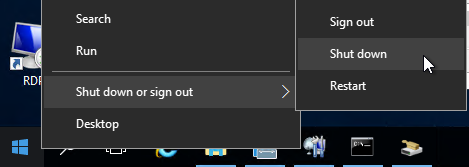
Troubleshooting – Graphics
If Windows 7 on vSphere, don’t install the VMware SVGA driver. For more details, see CTX201804 Intermittent Connection Failures/Black Screen Issues When Connecting from Multi-Monitor Client Machines to Windows 7 VDA with VDA 7.x on vSphere/ESXi.
For Citrix Policies that control graphics codecs, see https://www.carlstalhood.com/citrix-policy-settings/#graphics
Citrix Blog post – Optimising the performance of HDX 3D Pro – Lessons from the field
From Citrix Knowledgebase article CTX218217 Unable to span across multiple monitors after upgrade to 7.11 VDA, Black/Blank screen appears on the monitors while connecting to ICA session:
- For VDA 7.11 and newer, calculate the video memory that is required for monitors using the following formula :
SumOfAllMons (Width * Height) * 4 / 0.3, where width and height are resolution of the monitor. Note: There is no hard and fast rule that will work for all cases.Example: Consider the resolution of monitor 1 is 1920*1200 and monitor 2 is 1366*768. Then SumOfAllMons will be (1920*1200 + 1366*768)
- CTX115637 Citrix Session Graphics Memory Reference describes how multi-monitor resolution is determined.
- Open the registry (regedit) and navigate to:
HKEY_LOCAL_MACHINE\SYSTEM\CurrentControlSet\services\vd3d - Increase the value of “MaxVideoMemoryBytes” REG_DWORD value to the above calculated memory.
- Reboot the VDA
From Citrix Discussions: To exclude applications from Citrix 3D rendering, create a REG_DWORD registry value “app.exe” with value 0 or a registry value “*” with value 0.
- XD 7.1 and XD 7.5:
- x86: reg add hklm\software\citrix\vd3d\compatibility /v * /t REG_DWORD /f /d 0
- x64: reg add hklm\software\Wow6432Node\citrix\vd3d\compatibility /v * /t REG_DWORD /f /d 0
- XD 7.6/7.7/7.8/7.9/7.11 both x86 and x64:
- reg add hklm\software\citrix\vd3d\compatibility /v * /t REG_DWORD /f /d 0
Wildcards are not supported. The asterisk * here has a special meaning “all apps” but is not a traditional wildcard. To blacklist multiple apps e.g. both appa.exe and appb.exe must be done by creating a registry value for each app individually.
This is most problematic in Remote PC since most physical PCs have GPUs. I recently had to blacklist Internet Explorer to prevent lockup issues when switching back to physical.
Uninstall VDA
Uninstall the VDA from Programs and Features.
Then see CTX209255 VDA Cleanup Utility.
To run the VDA Cleanup Tool silently:
- Execute VDACleanupUtility.exe /silent /noreboot to suppress reboot.
- Once the VDACleanupUtility has finished executing, setup Auto logon for the current user.
- Reboot.
- After reboot, tool will launch automatically to continue Cleanup.
Another option is to delete CitrixVdaCleanup value under HKLM\Software\Microsoft\Windows\CurrentVersion\RunOnce. Then after reboot, run VDACleanupUtility.exe /silent /reboot to indicate that it’s running after the reboot.
Carl,
I am having a weird issue when creating or update the machine catalog and get stuck at the “Preparation” within VM until timeout. From the VM console,when checked the questioned VM, I got the “Operation System not found”. PXE-E51: No DHCP or proxyDHCP offers were received.
Any idea how to fix it?
Thanks
Hey Carl, i have a question.
Can i secure vdaport with a SSL certificate?
You mean port 80? No. It uses Windows Communication Foundation, which is authenticated and encrypted.
Hello Carl,
Hope you are well.
I can see that Citrix has introduced a new feature called storage RAM and discache for MCS from version 7.9 and want to check if we need to create a machine catalog for that new feature do we need add an additional hard drive to the virtual machine or the default HDD should take care of this?
Hope to hear from you soon.
Thanks,
Pavan
If the RAM cache is full, you probably want it to overflow to a disk. So yes, you allocate disk space for the overflow. It’s thin provisioned so it shouldn’t consume too much space unless the RAM cache is full. Note: the overflow disk essentially replaces the delta disk, but you’ll probably still see both disks in the VM configuration.
Thanks Carl. So the master Image will have two virtual disks associated with it? One for the base image and one for the memory cache?
Hi Carl,
I was wondering if there is a way to let MCS handle the delivery controllers when installing via CMD line? I have tried leaving ‘/controllers’ out of the cmd line, and also having ‘/controllers’ and leaving it blank. We have a few different farms.
I cant find this anywhere on the internet. Hopefully you have experience with this?
Thanks,
Andrew
Please find the below message when running Published App test in LoginVSI. I
Issues is due to the application simply not starting:
51 x
Published Application with name: Excel 2013, process name: excel.exe and window title: Excel did not launch in time, or engine was unable to match against the process name (and window title, if specified). Tried twice.
52 x
Published Application with name: Freemind, process name: javaw.exe and window title: Freemind did not launch in time, or engine was unable to match against the process name (and window title, if specified). Tried twice.
102 x
Published Application with name: PowerPoint 2013, process name: powerpnt.exe and window title: PowerPoint did not launch in time, or engine was unable to match against the process name (and window title, if specified). Tried twice.
126 x
Published Application with name: Word 2013, process name: winword.exe and window title: Word did not launch in time, or engine was unable to match against the process name (and window title, if specified). Tried twice.
99 x
Published Application with name: Outlook 2013, process name: outlook.exe and window title: Outlook did not launch in time, or engine was unable to match against the process name (and window title, if specified). Tried twice.
39 x
Published Application with name: Iexplore, process name: iexplore.exe and window title: Internet Explorer did not launch in time, or engine was unable to match against the process name (and window title, if specified). Tried twice.
2 x
The window with title Open did not appear, quiting workload
Is this issue with XenApp published application.
In all test run sessions? Or just some? If just some, that suggests slow performance on the server side. I believe Login VSI has a forum where you can ask this question.
Hi Carl,
Thanks as always for your incredibly helpful posts. I have a questions about the CQI. I have installed this on a series of test servers and noted that when enabled performance tanked. I did not think there would be much of a performance hit with this small app, but it really created a problem for these servers. I am sure I must have done something wrong. Any ideas.
Thanks,
Mike Altman
Mike,
Recommend submitting this feedback to the CQI team via the tool’s Podio Feedback Form. Doing so allows the CQI team to look into the reported concerns and address any potential issues with the tool.
https://podio.com/webforms/17047561/1146185
Sincerely,
LeonardoA
Hello Carl,
We’re having a strange issue with thin clients where when a user double clicks or initiates a few connections to a provisioned xendesktop group (win7) within a short period of time, the user is no longer able to make a connection at all. We’re currently running 7.12 Platform as well as 7.12 vda and target device. What is strange is that we can see session time outs for the user in director, but otherwise no indication of an issue within the environment. No open or disconnected sessions for the user are present either. We have scoured the event logs on all servers and also the VDA that Citrix was attempting to place the user on. We just caught onto this issue today. It appears to clear itself after an hour or so and eventually the user can connect. We are able to replicate the issue and the quick fix seems to be a reboot of the vda and a log out and back on to netscaler/storefront. We also plan to train users that a single click will suffice. I plan on contacting Citrix tomorrow, but I thought I would reach out and see if you or anyone has had a similar issue. Thanks as always!
Hello Carl,
I’m stuck on 7.12 with MCS and vSphere 5.5. When setting up a new Machine Catalog, I’m getting following message:
Error Id: XDDS:0DAA3833
Exception:
Citrix.Console.Models.Exceptions.ProvisioningTaskException An error occurred while preparing the image.
at Citrix.Console.PowerShellSdk.ProvisioningSchemeService.BackgroundTasks.ProvisioningSchemeTask.CheckForTerminatingError(SdkProvisioningSchemeAction sdkProvisioningSchemeAction)
at Citrix.Console.PowerShellSdk.ProvisioningSchemeService.BackgroundTasks.ProvisioningSchemeTask.WaitForProvisioningSchemeActionCompletion(Guid taskId, Action`1 actionResultsObtained)
at Citrix.Console.PowerShellSdk.ProvisioningSchemeService.BackgroundTasks.ProvisioningSchemeCreationTask.StartProvisioningAction()
at Citrix.Console.PowerShellSdk.ProvisioningSchemeService.BackgroundTasks.ProvisioningSchemeCreationTask.RunTask()
at Citrix.Console.PowerShellSdk.BackgroundTaskService.BackgroundTask.Task.Run()
DesktopStudio_ErrorId : ProvisioningTaskError
ErrorCategory : NotSpecified
ErrorID : FailedToCreateImagePreparationVm
TaskErrorInformation : Terminated
InternalErrorMessage : Failed to upload disk. Errors:HCL-VMware: WebException in UploadFile (attempt 0). System.Net.WebException: The remote server returned an error: (400) Bad Request.
at System.Net.HttpWebRequest.GetResponse()
at Citrix.PoolManagement.VMManager.VmmImplementation.Vmware.VmwareVmManager.UploadFile(Stream diskStream, Int64 fileLength, String name, String dataCenterName, String datastoreName, String targetFolder)
Our VMware Team did hardening on their platform. I assume the HTTP Datastore web browser access has been disabled. Is there a way to tell Citrix Studio at MCS to speak only HTTPS?
Thanks in advance.
Azur
In Studio > Configuration > Hosting, you’ll see the vCenter connection. Is it https? If not, you can edit the connection and specify https. But I thought 5.5 and higher required https.
Are you using a service account? If so, ask the VMware admins to verify the permissions at http://docs.citrix.com/en-us/xenapp-and-xendesktop/7-13/install-configure/install-prepare/vmware.html
Thanks for your reply.
The vCenter has been connected via https.
For testing purpose the VMware admins gave me full admin rights on the whole Data Center therefore I assume theres no issue with permissions.
Maybe they’ve disabled the http Data Store Access via web. I will keep you in loop as of I got any information.
Okay, now it is working.
enableHttpDataStoreAccess was disabled in vCenter advanced settings.
Go ahead with your posts and great stuff.
Regards,
Azur
Hi Carl, As always great site. We’re having issues with the screen resolution for users running Windows 10 with 4k monitors. The issues are as follows:
– Applications using the wrong DPI settings. When returning back into the office on Dual Screen 1920 x 1080 resolution this can be seen, but disconnecting + reconnecting the ICA session appears to resolve this.
-Applications take up large parts of the Screen which sometimes make them unusable.
-Applications such as console access via the ESX console cannot be used (Due to DPI)
Some other points:
-DPI settings are fine when RDP is used from home.
-Resolution has attempted to be lowered but we’d prefer to use the full capabilities of the 4k screen.
-Windows 7 does not appear to have the same issue.
-We are currently using the standard VDA (non3D).
Is there anything that can be suggested ?
thanks
Did you use the 4K monitors section of this article to adjust Citrix graphics registry values?
For how many users do you think these hardware recommendations will fit?
I was told to use a maximum of 16GB RAM and 4vCPUs for machines that can hold up to 10 users in RDSH Server 2012 R2 configured with VDA 7.12.
Thanks in advance.
By the way thats a nice HowTo!
2012 is more scalable than 2008. Citrix has tested 8 vCPUs with no issue.
Every app mixture has different hardware requirements so I can’t provide generalizations. I’ve seen some hosts with 10 users and other hosts with 100s of users.
Well … I heard something about using 8GB RAM and 2vCPUs and just thought that this can’t ever fit.
Do that 100 users infrastructures show up servers with 32GB RAM for 100 users users on that single server or do they have many servers with 32GB RAM for 100 users at all?!?
You have a hypervisor host that is dedicated to Citrix. It has a certain number of physical cores and memory. You need to partition the available hardware into VMs. You can either create one large VM to consume all physical resources. Or you can make a bunch of small VMs. Or you can do something in between. With Windows 2012, Citrix has found 8 vCPUs per VM to be the sweet spot. If your physical host has 48 logical cores, divide that by 8 vCPUs per VM, and you get 6 VMs per host.
Realistic hardware sizing is based on the number of users per physical host. You add up the number of users on every VM on that host. Divide the total number of users by the number of users per host to get the number of hosts you need. Then you can partition those hosts into whatever VM size maximizes the number of users per host.
The StubPath value in the .reg file should be this instead of what is listed, or the value will not import (needs the \\ instead of just \):
“StubPath”=”REG ADD HKCU\\Software\\Microsoft\\Windows\\CurrentVersion\\ImmersiveShell\\StateStore /v ResetCache /t REG_DWORD /d 0 /f”
Thanks for pointing that out. I updated the .reg file. Let me know if anything else needs to be corrected.
Hi Carl,
i got a Problem with the XenDesktop 7.12 VDA, if a Users logs out and the Session is closed, an Explorer Process is still running for a few Minutes. In a Procmon Log i can see that the Explorer.exe will access C:\Users\Mustermeier\AppData\Local\Microsoft\Windows\Explorer\TileCacheStartView-18110953_80.dat. The Explorer.exe will access also a few other TileCache… Files, after this the rest of the Profile will be written back to the Profilestore and the Session will completly closed.
Have you any Idee how can i solve the Problem?
Thanks.
Is it causing a problem?
Do you think this is a Citrix issue? I have not seen anybody else report this so you might have to call Citrix Support.
I got a solution for me, it seems like a Bug in the VMWare Tools (5.5.0 Update3) with the previous VMWare Tools the Problems are gone.
Hi Carl,
We just installed XenApp 7.12 in our test environment. On one site we have 2 DDC and 2 VDA (all Windows Servers 2008R2), also we have the same configuration at one remote location as well. On our DDc, we got Event ID 1193, and on the VDA we got 1002, 1017 and 1022. Occasionally we got ID 1012 (Successfully registered with DDC). We did open a case with Citrix but so far no solution just yet. Can you shed some light on how to go about fixing these issues.
Thank you so much
Vinh Le
Vinh Le,
Did you ever find a resolution for your 1193 issue? We are currently having the issue and not finding anything. We have had our environment running with no changes for over a month and just started seeing this.
@Carl, do you have any new thoughts about this?
Thank you,
Dear Carl,
Your website is very helpful and informative.
Thanks a million!
Hi Carl, we have installed VDA 7.12 and we have some trouble with few things.
First and most annoying is: after upgrade the VDA and first logon of the domain user with no local account enables “use checkboxes to select items”. Can you please help how to disable it or how it cut out from the VDA instalation via parameters?
Second thing: the top bar when RPD comsole is active is larger than before even if I am connected on my PC – not mobile device.
Thanks in advance for any answer,
Daniel
Did you maybe modify the Default User profile somehow? Maybe somebody did it when building the image.
Carl, I really appreciate all the work you put into this site. Its truly invaluable! I’m relativity new to Citrix and have a basic question that is probably quite ridiculous. In the windows prep section you state “if RDSH disable IESec…” i see the RDSH reference other places and it is confusing for me. Doesnt every VDA server get RDS installed automatically as its used for hosted apps or a vdi environment? Is there something I’m missing when that RDSH tag is used? Is it just synonymous with a VDA server or does it imply some additional function that isn’t set by default? (for example if your windows prep section is there a situation when buildinga VDA that IESec wouldnt be disabled?)
Thanks
RDSH = Remote Desktop Session Host, which is a role that is installed on Windows Servers that allows multiple users to login at the same time. This is what’s traditionally known as XenApp.
Virtual Desktops don’t have an RDSH role, and thus only one user per machine.
Only RDSH uses IE Enhanced Security Config.
I have the cert, installed it but when running the Enable-VdaSSL.ps1 get the following error:
“Verification of the certificate failed. Please install a valid certificate and try again.”
The cert was generated with a CNG template CSR, it has a private key that corresponds to the cert, but the key is not easily accessible from powershell. Do I need to generate a new CSR/Cert with a Legacy template?
Did you resolve this issue? I am currently experiencing it and searching a fix.
Has anyone been able to successfully upgrade a 2012R2 master PVS image to Windows 2016?
Is it possible to upgrade from XenDesktop 7.11 to 7.12 silently? I have used the citrix command lines to do so and it fails everytime. I previously upgraded from 7.9 to 7.11 without issue.
What kind of failure? Something in the log?
Hi, thanks for the reply….this is the failure from XenDesktop Installation.log
11:24:48.6341 $ERR$ : XenDesktopSetup:Installation of MSI File ‘profilemgt_x64.msi’ failed with code ‘InstallFailure’ (1603).
11:24:48.6361 $ERR$ : XenDesktopSetup:InstallComponent: Failed to install component ‘Citrix User Profile Manager’. Installation of MSI File ‘profilemgt_x64.msi’ failed with code ‘InstallFailure’ (1603).
11:24:48.6361 $ERR$ : XenDesktopSetup:Recording installation failure. Installation of MSI File ‘profilemgt_x64.msi’ failed with code ‘InstallFailure’ (1603).
There should be a separate install log for UPM. Check that log.
Where does this separate install log reside?
I think it’s under %userprofile%\AppData\Local\Temp\XenDesktop. There’s a separate log file for each component.
The main log file you’re looking at also references the log file paths for each component.
I just installed vda 7.12 via your command line and it included Personal VDisk on 2008R2.
I believe that’s needed for AppDisk.
Carl have you put together any instructions for Creating RDSH desktops using Server 2016 yet? Im looking to test out Server 2016 desktops soon and wanted to see if you ran into any snags or caveats.
I have several customers doing it. Should be same as Windows 2012 R2.
There is no GSLB configured. Is their a way to achieve it without? Is that a requirement? When i searched for SRID, it mentions “Identical means: same Base URL, same farms (Manage Delivery Controllers), same SRID, same Gateways, and same Beacons.” So I can setup same Base URL for each satellite zone office and the primary zone office, ofcourse they have their own DDC’s particular to the zone, and they each have their own NetScaler, but the Gateway has to Optimally Route to the zone and the SRID has the be the same across all StoreFront’s
\inetpub\wwwroot\Citrix\Roaming\web.config file. Is my understanding right?
For zones, if you include the zone name in the header, then you can choose Optimal Gateway based on zone name. https://docs.citrix.com/content/dam/docs/en-us/netscaler/11/downloads/global-server-load-balancing-powered-zone-preference.pdf
GSLB is not required, but is typical for multi-datacenter.
The idea is that users can go to any StoreFront in any datacenter. If you don’t need that functionality, then each can have separate configs.
Hi Carl, have you ever seen the listofddcs set up with ddcs from across a global setup – 1 site but different network ddcs? What I mean is 1 SQL server with the 3 dbs in home datacenter, the home datacenter has 2 ddcs, the other 4 geographically dispersed offices each have 2 ddcs as well, all of these joined into 1 global site. I am having trouble looking at this because the VDAs at each site are on different networks, there may be latency, and ofcourse the listodDDCs would be listing 10 ddcs in total – so not sure how that would work in terms of using the local ddcs of any site, etc. Unless I somehow just use the local ddcs for the VDA and leave out the rest that are available? What do you think?
That’s the purpose of zones. https://www.carlstalhood.com/catalogs-delivery-groups/#zones Zones configure ListOfDDCs to register with the local DDCs with failover to remote DDCs.
Thanks Carl that makes sense. How about configuring the storefronts? Each sat zone site has two and same for primary zone. Would optimal gateway best? Do you have any instructions for that?
Optimal Gateway at https://www.carlstalhood.com/storefront-3-5-configuration-for-netscaler-gateway/#optimal
Would the storefronts have or should they same base URL in across all zones to make the stretch global site
For GSLB, yes. Every StoreFront should be identical. Search for SRID at https://www.carlstalhood.com/storefront-3-5-configuration-for-netscaler-gateway/#multisite
Hi Carl,
Could you elaborate on the vSphere suggestion to reserve Memory and disable Memory Hot Plug (PVS Scenario and in General)
?
Thanks
Dynamically changing memory might affect PvS memory caching. So you’d want to prevent vSphere from doing that. In vCenter, you can edit a VM and reserve all of its memory. If you click the arrow next to Memory, you can disable hot plug if it’s enabled.
oh, good point, thanks!
This is great stuff Carl. Thank you sir.